Australian Resources & Investment



The next step in the evolution of underground mechanical rock excavation is here. The Mobile Miner family consists of powerful mechanical rock excavation machines that are fully customisable to your specific needs. The continuous mining technology makes your project more productive, more predictable and easier to schedule compared to the drill and blast method. It also creates a safer and cleaner work environment due to no explosions, less need for ventilation and a much lower risk for falling rocks - a safer work environment for everyone.


When IMARC takes place in Sydney in November, the resources industry will be able to reflect on 2022’s achievements while establishing the building blocks for 2023 and beyond.
2022 has whizzed by and by the time the International Mining and Resources Conference (IMARC) arrives in Sydney in November, industry professionals will have a solid reference book of the year’s achievements and lessons learned.
These insights will form the basis of discussion and collaboration between fellow mining leaders and resource experts, facilitating the sector’s continued transformation into 2023 and beyond.
And sustained growth it will need.
PricewaterhouseCoopers’ (PwC) ‘Mine 2022’ report shines a light on what it believes is the resources industry’s most pressing concern: critical minerals.
“(Critical minerals is a pressing issue) on the back of that transition to a low-carbon world, and the massive amount of investment that’s needed to support that,” PwC Australia partner Marc Upcroft said.
“And it’s becoming clear to us that if you’re trying to achieve the energy transition on the current target and timetable, this only happens if there’s a substantial increase in exploration, discovery, development and mining of critical minerals.”
The resources industry has its work cut out for it, and it’s events such as IMARC that can accelerate the dialogue needed to foster the sector’s critical minerals future.
Hawsons Iron graces the front cover of our October issue, and we chat to managing director Bryan Granzien about the company’s incredible growth in the 14 months since the company changed its name from Carpentaria Resources.
Harnessing the strengthening ‘green steel’ narrative, while continually de-risking its namesake project at the same time, Hawsons Iron’s share price was up by more than 450 per cent year-onyear when this issue went to print.
We shine a light on the happenings of Diggers & Dealers 2022, where gold and battery metals took centre stage.
Here, the likes of BHP, Newcrest Mining, Agnico Eagle, IGO, Lynas Rare Earths, Genesis Minerals and St Barbara gave fascinating insights into their projects and the resources sector more broadly.
We chat to Diatreme Resources’ chief executive officer Neil McIntyre about the complexity of the silica sand market and how the company is progressing en route to becoming a producer.
Tony Featherstone explores the soaring coal market, and how its current performance contradicts overarching sentiments regarding the maligned sector.
The sustained uncertainty surrounding the global iron ore market is also discussed, with China set to have greater control on pricing and negotiations through a new state-owned iron ore purchaser. So how will this affect Australia’s iron ore producers?
Elsewhere, there’s chats with ASX-listed mining services companies RPMGlobal, Duratec and Mitchell Services, while we also explore IMARC in greater detail.
Happy reading.
Tom Parker EditorEDITOR
TOM PARKER
Email: tom.parker@primecreative.com.au
MANAGING EDITOR PAUL HAYES

Tel: (03) 9690 8766
Email: paul.hayes@primecreative.com.au
CLIENT SUCCESS MANAGER JUSTINE NARDONE Tel: (03) 9690 8766
Email: justine.nardone@primecreative.com.au
SALES MANAGER
JONATHAN DUCKETT Mob: 0498 091 027
Email: jonathan.duckett@primecreative.com.au
BUSINESS DEVELOPMENT MANAGER TONY NGUYEN Mob: 0411 059 305
Email: tony.nguyen@primecreative.com.au
SALES ADMINISTRATOR
EMMA JAMES
Tel: (02) 9439 7227 Mob: 0414 217 190
Email: emma.james@primecreative.com.au
DESIGN PRODUCTION MANAGER MICHELLE WESTON michelle.weston@primecreative.com.au
ART DIRECTOR BLAKE STOREY blake.storey@primecreative.com.au
KERRY PERT, LOUIS ROMERO
FRONT COVER IMAGE CREDIT: Hawsons Iron
SUBSCRIPTION RATES Australia (surface mail) $120.00 (incl GST) Overseas A$149.00
For subscriptions enquiries please contact (03) 9690 8766 subscriptions@primecreative.com.au
PRIME CREATIVE MEDIA 11-15 Buckhurst St, South Melbourne, VIC 3205, Australia www.primecreative.com.au
© Copyright Prime Creative Media, 2021
All rights reserved. No part of the publication may be reproduced or copied in any form or by any means without the written permission of the publisher.
PRINTED BY MANARK PRINTING 28 Dingley Ave Dandenong VIC 3175 Ph: (03) 9794 8337
Published 12 issues a year


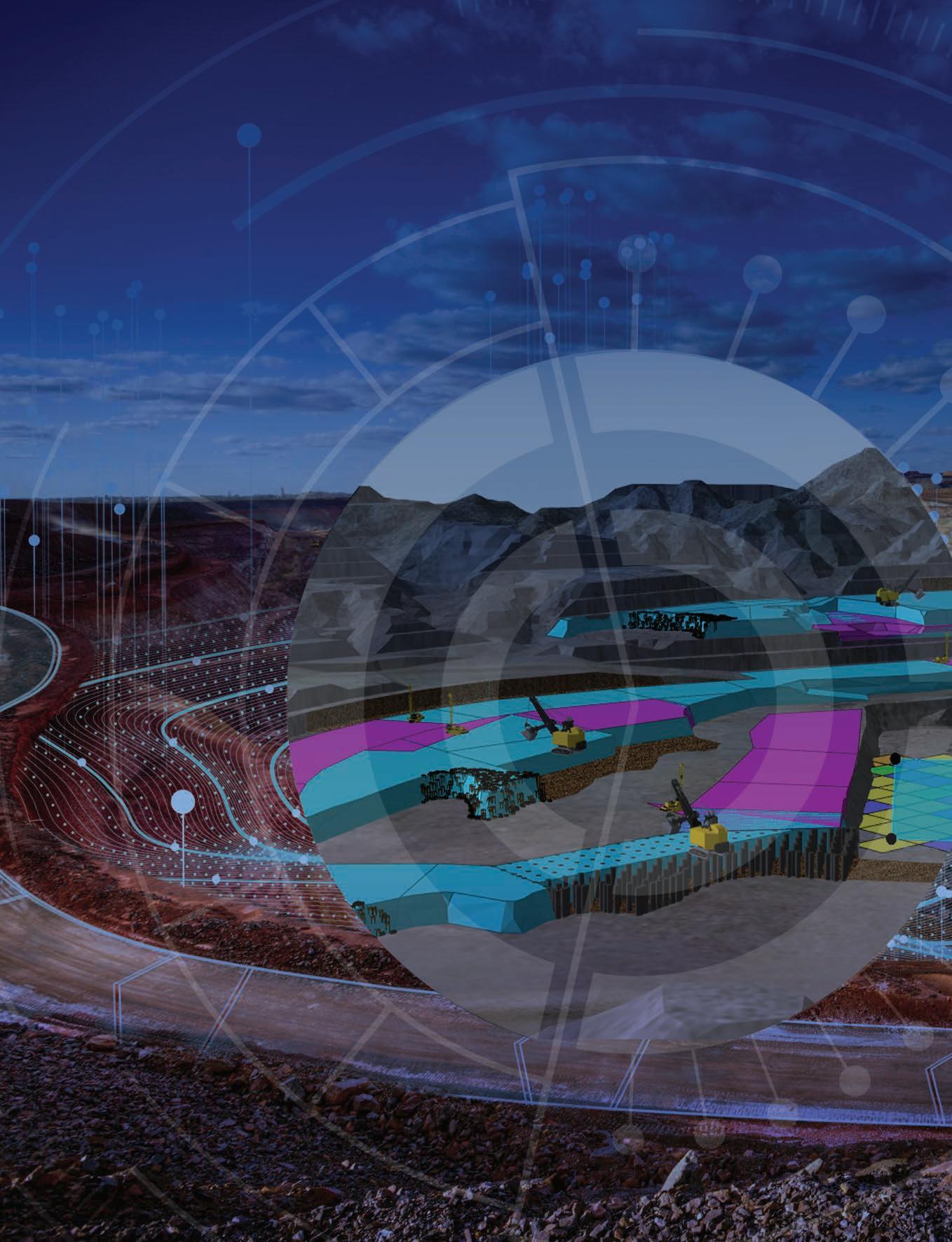

Big producers have seen record earnings as the energy crisis intensifies, but the sector is fully valued for now.
If Australia’s coal sector is in trouble, someone forgot to tell ASX-listed coal stocks.
Many have soared this year, continuing a remarkable rally that has frustrated investors who gave up on the sector.
In the recently concluded 2021–22 financial year (FY22) earnings season, leading coal producers reported record profits, buoyed by strong prices. Several coal companies increased their dividend and some announced share buybacks to return excess cash to shareholders.
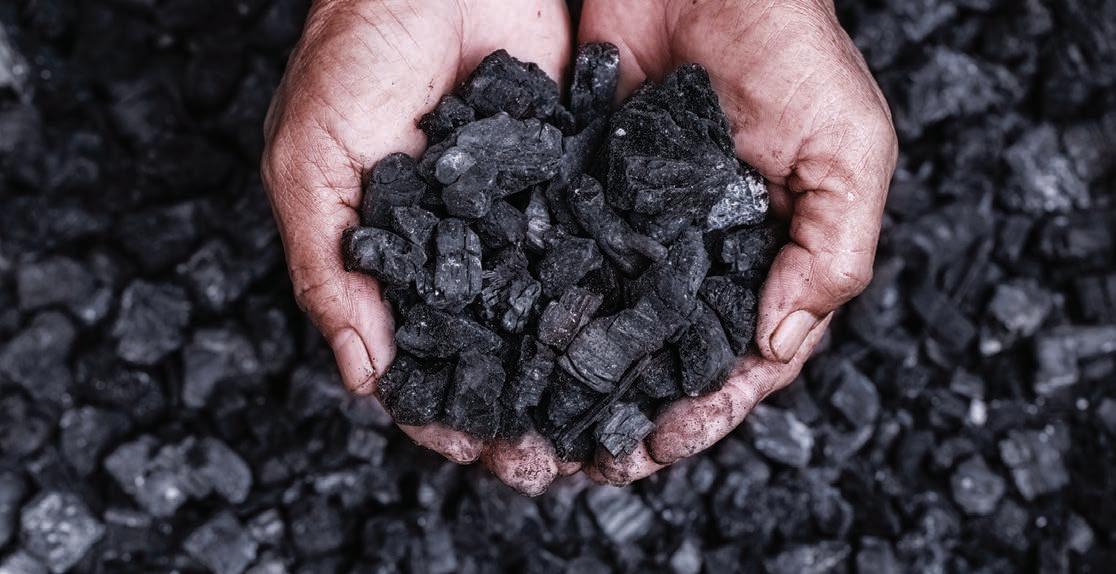
But can the rally continue?
After such strong gains, coal stocks are due for a period of consolidation. The question is whether the rally can find its next leg.
Australian Resources & Investment analysis of 10 of the largest coal-related stocks highlights the rally. The median total return of these stocks (assuming dividend reinvestment) is 150 per cent over one year to early September 2022.
Over three years, the average annualised return is 41 per cent. For context, the S&P/
ASX 200 Accumulation Index (including dividends) returned one per cent annually in this period.
At a company level, the rally in coal stocks this year has been breathtaking. Sector star Whitehaven Coal has surged almost fourfold to $8.63* from its 52-week low of $2.30.
Chinese-owned Yancoal Australia has leapt almost threefold to $6.15* from its 52week low of $2.23.
New Hope Corporation, Stanmore Resources, Coronado Global Resources and Bowen Coking Coal have also starred.
TerraCom (formerly Guildford Coal) has gone from a 52-week low of $0.15 to almost $1.02*.
But percentage gains can deceive.
Coal stocks mostly plunged between 2018 and early 2020 as fossil-fuel producers lost favour with investors. Some funds that use environmental, social and governance (ESG) filters avoided the sector.
At the time, technology stocks were in vogue thanks to record-low interest rates (which benefit companies with long-duration earnings) and a seemingly insatiable appetite for growth companies. Fewer investors wanted to buy coal stocks.
Contrarians who bought coal stocks when the sector was on its knees deserve their gains. Of course, not every coal stock has starred. Coal-related companies such as Aurizon Holdings, a rail operator, and Dalrymple Bay Infrastructure, a port operator, have underperformed. Some coal-services stocks have struggled.
Also true is that coal companies, like other minerals producers, benefited as commodity prices soared during the early stages of Russia’s invasion of Ukraine amid a growing global energy shortfall. Record-high coal prices were a huge tailwind.
Nevertheless, the sector’s share-price rally this year has strong foundations.
What ultimately matters most is company earnings. On this score, leading Australian
coal companies have superbly capitalised on the conditions to deliver booming profits.
Whitehaven reported revenue of $4.9 billion for FY22, up from $1.57 billion a year earlier. Underlying earnings (EBITDA) were $3.06 billion in FY22, up from $204 million in FY21. Whitehaven declared a fully franked dividend of $0.40 a share (on top of an interim dividend of $0.08) and continued its share buyback.
In August, Yancoal Australia reported record revenue and earnings. Sales leapt to $4.76 billion in the first half of FY22 from $1.75 billion in the same period a year earlier. Underlying earnings were $3.15 billion in the first half, up from $406 million.
Stanmore Resources reported underlying earnings of US$726 million for the first half of FY22, up from a $10.1 million loss in the same period a year earlier. Stanmore’s acquisition of BHP Minerals’ 80 per cent interest in BHP Mitsui Coal in May 2022 was well timed. Stanmore is also acquiring the remaining 20 per cent from Mitsui.
These and other earnings results from coal producers had a common theme: strong coal demand and tight supply underpinning record thermal coal prices.
“Events over the past two years have caused a shift in global trade flows and tightened the supply of all coal products, leading to strong demand and record high prices,” Whitehaven noted in its FY22 results.
“Global supply/demand imbalances are expected to continue to support high coal prices.”

As prices for thermal coal (used in electricity-generation) rise due to Indonesia’s export ban last year and the Russia–Ukraine war this year, process for metallurgical coal (used in steel production) fell in the fourth quarter of FY22. Fears of a global economic recession and lower steel demand weighed on metallurgical coal.
Analyst valuations of leading coal stocks suggest the sector is fully valued for now, although not excessively so given the extent of recent gains. A consensus share-price target among analysts of $8.50 suggests Whitehaven is at fair value.
Morningstar, however, values Whitehaven at $9 a share. As analysts continue to upgrade earnings forecasts for top coal producers, it’s likely that company valuations will also rise, suggesting some value remains in the sector.
Fast-growing coal producers, such as Stanmore Resources and Coronado Global Resources, still trade below consensus analyst forecasts (compiled by FN Arena). New Hope Corporation trades slightly above the consensus price target.
Care is needed with consensus price targets. Some coal stocks have limited analyst coverage, meaning the consensus target is based on a small sample of
Tony Featherstone is a former managing editor of BRW, Shares and Personal Investor magazines. The information in this article should not be considered personal advice. It has been prepared without considering your objectives, financial situation or needs.
Before acting on information in this article, consider its appropriateness and accuracy, regarding your objectives, financial situation and needs. Do further research of your own and/or seek personal financial advice from a licensed adviser before making any financial or investment decisions based on this article.
research. In addition, many ASX-listed coal stocks are too small to attract significant broking research.
Caveats aside, consensus estimates suggest two main views towards coal stocks: first, that the sector is now fully valued after soaring gains this year; second, that value still exists within the sector over the medium term (3–5 years), largely on supply constraints.
Both arguments have merit.
Coal producers such as Whitehaven have justified their price gains with soaring earnings. But several tailwinds for the sector are turning into short-term headwinds, best reflected in falling metallurgical coal prices.
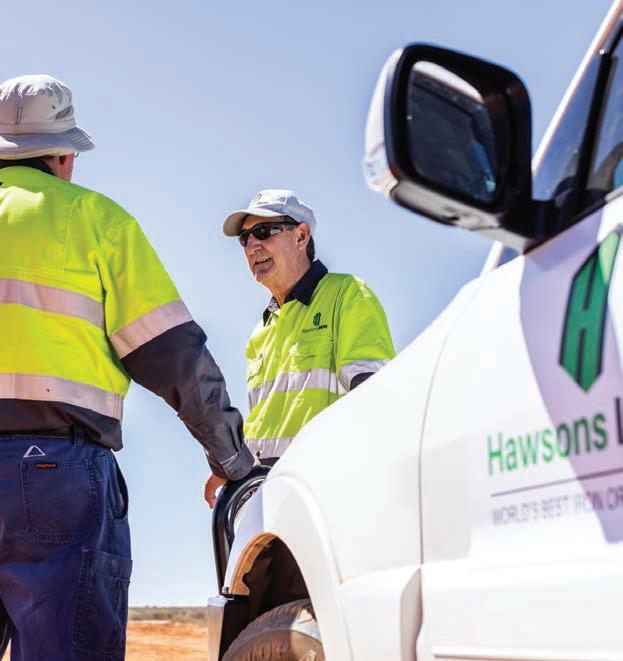
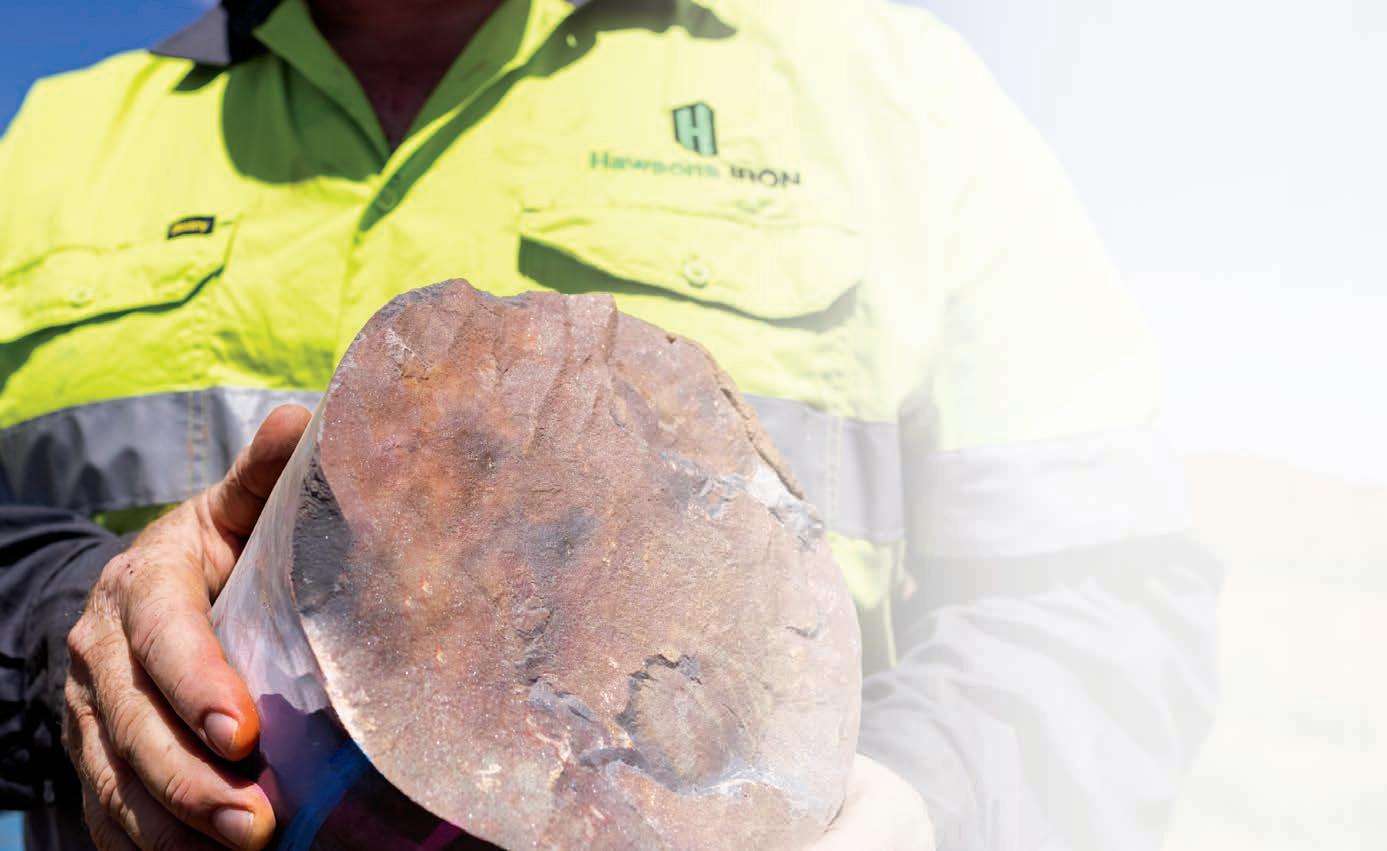
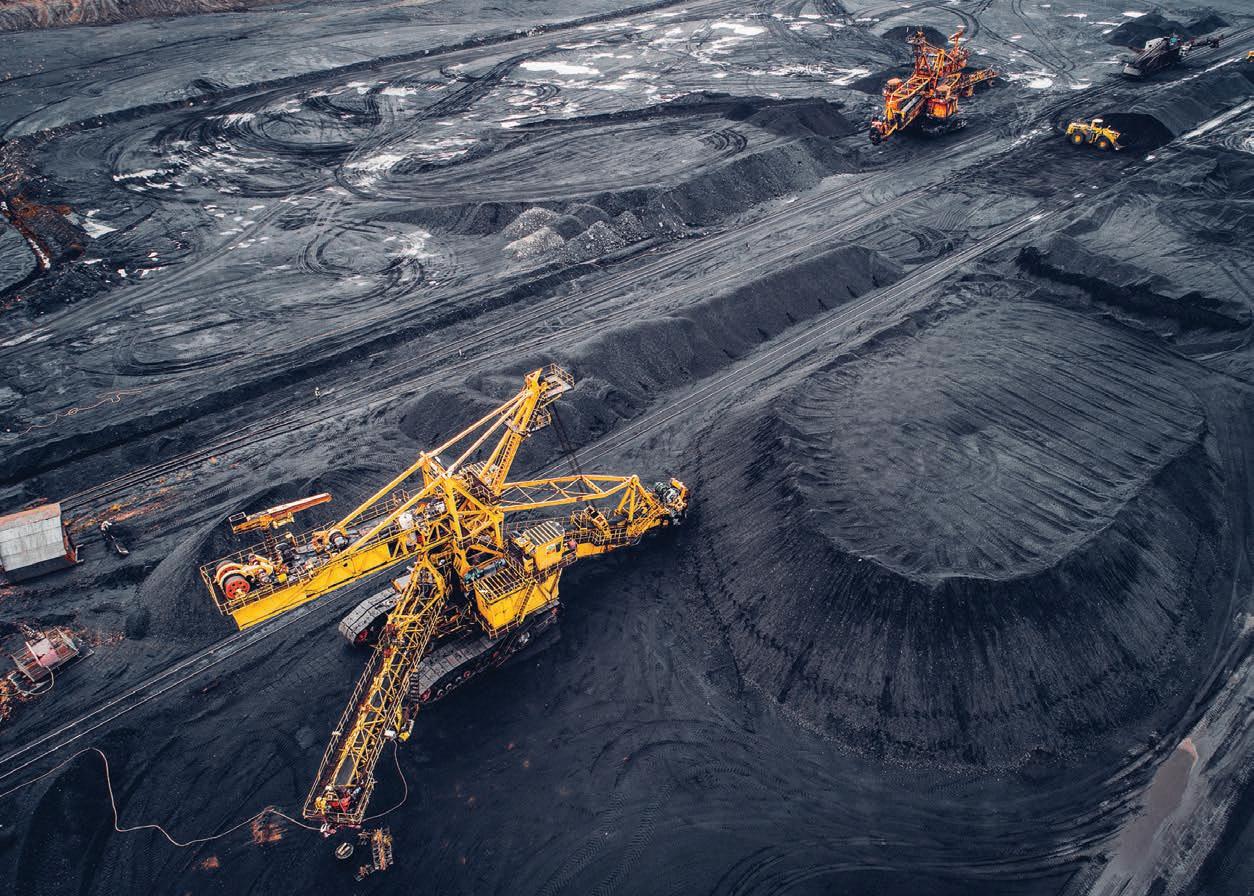
The biggest headwind is the prospect of global recession and potential demand destruction for some commodities. China’s economic slowdown is particularly concerning for steel production and metallurgical coal demand. After rising in the first half of 2022, Chinese steel production fell sharply in June and July.
Against that, there have been ongoing rumours of China lifting its ban on Australian coal. This speculation boosted coal stocks in July, though it seems premature given
lingering trade tensions between China and Australia.
On balance, a period of consolidation for coal stocks seems likely in the short term as leading producers maintain (or give back) some of their recent gains. Investors should watch and wait for better value in the sector over the next 12 months.
However, medium-term (3–5 years) prospects for coal production remain encouraging. Wood Mackenzie, a commodity forecaster, predicts global demand for coal will stay largely flat to 2030. Advanced economies will face a structural decline in demand to 2050, while developing economies will see continued demand growth for coal.
Geopolitics are another factor. The Russia–Ukraine war has reinforced the risks of relying on autocratic nations for energy supply or moving too quickly towards renewables when there is not sufficient baseload power supply. European and North Asian countries now face a challenge in replacing Russian coal – a positive trend for Australian coal.
Unlike previous commodity supercycles that were largely driven by demand factors,
this one is being driven more by supply. The boom in ESG investing and the move away from capital investment in fossilfuel production in coal and oil limits future supply.
Oil supermajors, for example, are investing far less in new production compared to previous cycles. This long-term supply–demand dynamic could underpin high coal prices for longer than the market currently realises.
Few people doubt the world needs to move towards clean energy and away from fossil fuels like coal over the coming decades, or that more investors will avoid coal stocks on ESG grounds when building portfolios. That’s their right.
But as the recent profit-reporting season has shown, the market underestimated the earnings and growth potential of Australia’s coal sector. That might continue to be the case in the next few years if the market does not fully appreciate future supply constraints in coal and oil.
The key is buying into the sector during periods of market volatility.
*Share prices are determined as of September 20.





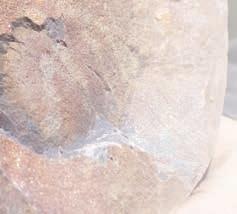





WE ARE ALL part of the race to become more environmentally friendly. A significant part of that race is global electrification, which involves world powers scrambling to gather the necessary minerals required for the process – and our progress.
It seems graphite is currently viewed as the ‘dark horse’, but we suggest aluminum may tie this race.
Leaving aside clichés, there has been a massive global surge in research and development for energy storage solutions. The University of Queensland is a key part of that research.
Still an essential part of the humble pencil, graphite is the second largest component by weight in lithium batteries and plays an integral role in electrification.
A hybrid-gasoline electric vehicle (HEV) can carry up to 10kg of graphite, and a plug-in electric vehicle (EV) has around 70kg. This would equate to more than 70,000 tonnes of natural graphite for the production of every million EVs.
Coupled with this is the growth of other electronics that rely heavily on lithium-ion batteries, as well as forthcoming developments in portable tools and energy-storage applications.
Producing around 60 per cent of the world’s flake graphite, China is the world’s largest supplier of the mineral, followed by Mozambique and Brazil. Graphite is also produced in Canada, India and Russia. Interestingly, the US – one of the main global forces in the EV industry – has been late to the party on mining graphite.

In Australia, Quantum Graphite’s (ASX: QGL) Uley graphite project is within the wholly owned Mikkira graphite deposit located on the Eyre Peninsula in South Australia.
The company’s proprietary process is environmentally sustainable and entirely based on renewable energy, and its joint venture with Sunlands Co. sees them use their technology to manufacture the flake graphite-based storage media to be installed within long duration energy storage cells.
The jagged and gapping actions of the share price history for Quantum Graphite restricts our analysis to a starting point in December 2021. The price rose strongly into 2022 to halt in momentum divergence at $0.38 in February, pulling back to test support at $0.24 before regaining its momentum.

Breaking away through $0.38 in early May, the price reached another momentum hurdle at $0.52 on May 23. The price has since paused and pulled back to bounce from support at $0.325.
It’s likely that more price churning may occur between $0.32 and $0.43 as momentum rebalances. Beyond this, we would look for a return to the upward path through the $0.45–0.52 area for a potential into the $0.70–0.80 range. A fall through $0.275 may produce a deeper pullback.
Magnis Energy Technologies (ASX: MNS) is also listed on the New York over-the-counter and Frankfurt markets. The company has vertically integrated its lithium-ion battery technology and materials by holding strategic assets, investments and partnerships in the electrification supply chain.
Along with its US partners, the company operates a gigawatt-scale lithium-ion battery manufacturing project
in Endicott, New York. It has plans to commercialise and patent technology to develop green-credentialed lithium-ion battery cells, with the aim to produce high-performance anode materials utilising ultra-high-purity natural flake graphite from the its Nachu graphite project in Tanzania.
The share price for Magnis Energy has been on a rollercoaster ride from the early 2000s. Following a peak at $2.17 in January 2007, the price fell sharply to a low and turning point around $0.10 in October–December 2008. This spurred a significant recovery to $0.89 in early 2011.
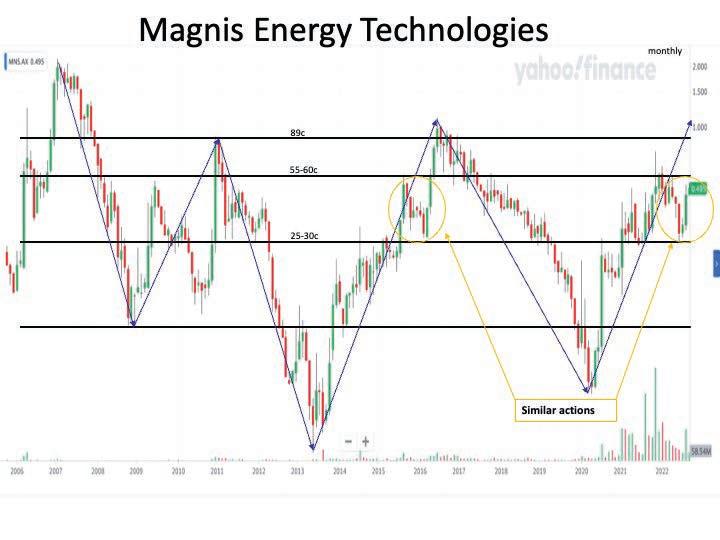
The pattern of strong upthrusts followed by sharp declines continued with a spike low at $0.24 in mid-2013 and then an interim high at $1.12 in June 2016. The most recent low was $0.47 in April 2020. At this time, a strong reversal developed and expanded to support the 2021 upthrust, which reached $0.755 in November last year.
The price has pulled back in line with a momentum peak, finding support drawn back to 2008 in the $0.25–0.30 range. The action appears similar to that experienced in early 2016, when the price tackled resistance in the $0.55–0.60 area before breaking through and surging higher.
A similar outcome would see the price head towards $0.89 through $1.00 and possibly into the $1.50–2.00 range. A drop below $0.40 may delay the upward path.
Now for the next step.
The University of Queensland’s Australian Institute for Bioengineering and Nanotechnology has been using breakthrough technology for the creation of graphene aluminium-ion cells. The innovative discovery with the Graphene Manufacturing Group (listed on the Toronto Stock Exchange) claims to charge 60 times faster than the best lithium-ion cells, and can hold three times the energy of the best aluminiumbased cells.
The aluminium-ion battery composition consists of an aluminium foil anode, a graphene cathode, and an aluminium-chloride electrolyte. The batteries contain no lithium, copper, manganese, or cobalt. They are safer, with no upper ampere limit to cause spontaneous overheating. Due to their stable base materials, the batteries are easily recyclable, charge much faster and provide a longer range, resulting in a more sustainable outcome.
The technology has been referred to as “game-changing”, offering a real alternative to the existing lithium-ion batteries in almost every application.
With its Toronto Stock Exchange listing, Graphene Manufacturing Group’s share price is quoted in Canadian dollars. The price has been moving in a broad upward channel from the middle of last year, and from July this year has encountered resistance from its mid-way channel in the $C4.00–4.20 zone.
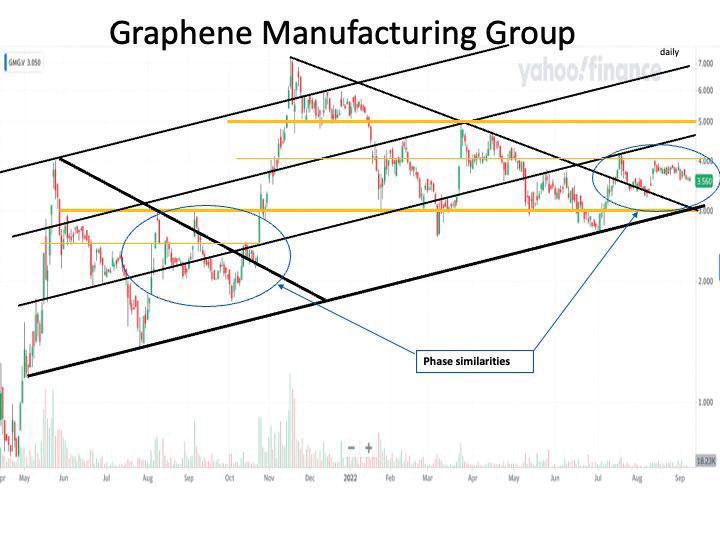
More churning may occur in the price action beneath this barrier with support in the $C3.00–3.50 area with an upward breakaway through $C4.20, signalling the next stage higher towards $C5.00 and potentially $C6.00 and possibly much higher. A drop below $C3.00 may produce heightened price volatility.
As the great battery race enthrals the world and energy research strives for new and better options, lithium and graphite remain the key elements for the time being, but aluminium is likely to provide a paradigm shift.
Magnis Energy’s share price has been on a rollercoaster ride since the early 2000s. Graphene’s share price trajectory on the Toronto Stock Exchange.Since changing its name from Carpentaria Resources, Hawsons Iron has experienced incredible growth as it advances its namesake magnetite project.
When Hawsons Iron Limited was established in August 2021, it kickstarted an exciting new chapter for the burgeoning iron ore miner.

Each milestone in the past 14 months has progressively de-risked the Hawsons Iron project and further highlighted the potential of its Hawsons Supergrade product (70 per cent iron).
And investors are buying in. The company’s share price was trading at $0.45 at the time of writing (September 19), which was up more than 450 per cent year-on-year.
In March 2022, Hawsons Iron purchased the full stake in its namesake project after acquiring the remaining 6.04 per cent interest owned by Starlight Investment Company.
Hawsons managing director Bryan Granzien said acquiring the remaining stake enabled the company to manage the
bankable feasibility study (BFS) and project build “more efficiently and effectively”.
“No doubt, removing this potential complication at the joint venture level, opens all avenues for the company to move forward, including the consideration of strategic joint venture partners later if, or when, we wish to,” Granzien said when the announcement was made.
“We see this as a strategically important transaction, as it really paves the pathway for the future.”
In June 2022, Hawsons Iron made a significant announcement by opting to develop a 20-million-tonne-per-annum (Mtpa) project rather than the 10Mtpa option outlined in the 2017 pre-feasibility study (PFS).
Granzien said the 20Mtpa option improves the environmental, social and governance (ESG) profile of the project,
as the transport method utilises an underground slurry pipeline instead of rail.
Granzien said 20Mtpa also facilitates greater opportunity to attract capital investment.
“You could argue that was a brave decision by the board, changing from a PFS model of 10Mtpa using existing infrastructure into one of the largest undeveloped iron ore mines and, when operational, a large-scale mine crucial to filling the significant supply shortfall expected for high-grade magnetite for green steel,” Granzien told Australian Resources & Investment.
“(Opting for 20Mtpa) has really made the market look very differently at the project and its potential.”
Granzien said Hawsons Iron’s July 2022 resource upgrade was another key milestone.
This saw Hawsons upgrade the project’s mineral resource to 3.95 billion tonnes at a 12.2 per cent DTR (magnetite recovery rate) for 484 million tonnes (Mt) of concentrate, including a maiden 54Mt in the measured category (193Mt indicated and 239Mt inferred).
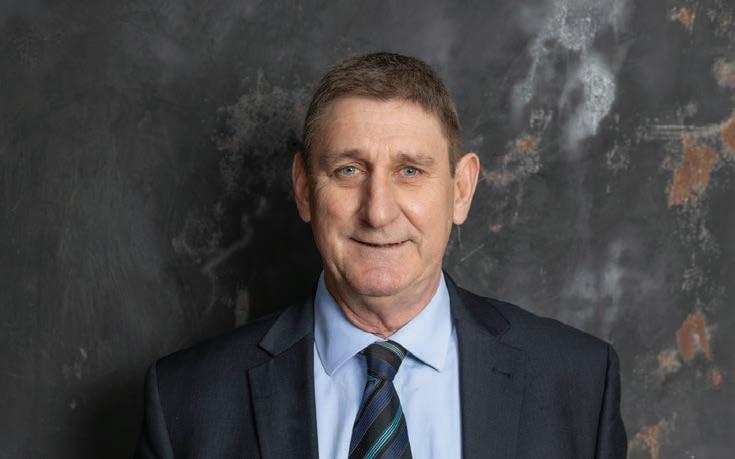

“The combined measured and indicated resource of 247Mt sets up the BFS for the ore reserve estimation to satisfy project lenders that there is sufficient high-grade material to confidently meet targeted minimum concentrate production of 20Mtpa,” Granzien said.
“This upgrade is significant because having these mineral resources in the higher confidence measured and indicated categories is necessary for the BFS,
converting our resource to reserves and finalising our project financing package.”
Underpinning the decision to go ahead with the 20Mtpa option was the execution of a non-binding memorandum of understanding (MoU) with Flinders Ports.
As part of this agreement, Flinders Ports will finance, construct, own and operate the Myponie Point port in South Australia, reducing Hawsons Iron’s capital requirements in the process.
The next step will be for Hawsons Iron to upgrade its Flinders Ports partnership to a binding agreement, which will effectively unlock Myponie Point and Hawsons’ export pathway to the world.
Granzien said the Federal Government renewing Hawsons Iron as a major project
in April 2022 was another significant milestone, along with the South Australian Government’s recent declaration that it will assess its potential as a major project.
Hawsons Iron also has the recognition of the New South Wales Government, which has declared the project a State Significant Development.
“Now you’ve got the Federal Government, the New South Wales Government and the South Australian Government recognising the potential and importance of this project not just from an economic point of view, but as a significant player in helping to decarbonise the steel industry,” Granzien said.
Granzien said South Australia’s “major project” declaration had the potential to help streamline approval processes.
“This is very much recognition that this is large scale with significant economic potential to South Australia. It fits well with South Australian plans around hydrogen, green steel and opening up the Braemar minerals province.
“And it’s a good ESG story, so it’s consistent with how they’d like to see sustainable development of mining in the future.”
In September 2022, Hawsons Iron engaged Citigroup Global Markets Australia (Citi) as a strategic advisor to assist in assessing strategic partnering opportunities for its namesake project.
Granzien said this was the formalisation of an established relationship with Citi.
“This was something we’ve been working on with Citi for some time, so it didn’t come out of left field,” Granzien said.
“We’ve been talking to them on several fronts and we’ll continue to do, so this is part of a larger relationship.
“Citi is one of world’s biggest banks in terms of investment in the resources industry. They’ve got a large amount of funding available to ESG projects and they’ve probably got the biggest global network or reach to steel mills and other investors.”
Paul Cassano, who Hawsons Iron has appointed as its new project director, will take responsibility for leading the preparation of the BFS.
With more than 30 years’ experience in the resources sector, Cassano has held divisional chief executive officer and executive general manager roles at Downer, along with an executive general manager role at Thiess. He also held several management roles with BHP Billiton in the past.
Hawsons Iron’s next priority is producing a compelling BFS, which Granzien said would enable the company to raise the capital needed to build the Hawsons Iron mine and its associated infrastructure.
The BFS will demonstrate Hawsons Iron’s capacity as an operating mine, authenticating the project’s many components.
Preparing a BFS is a complex exercise, so Hawsons has engaged several external companies to support its completion.
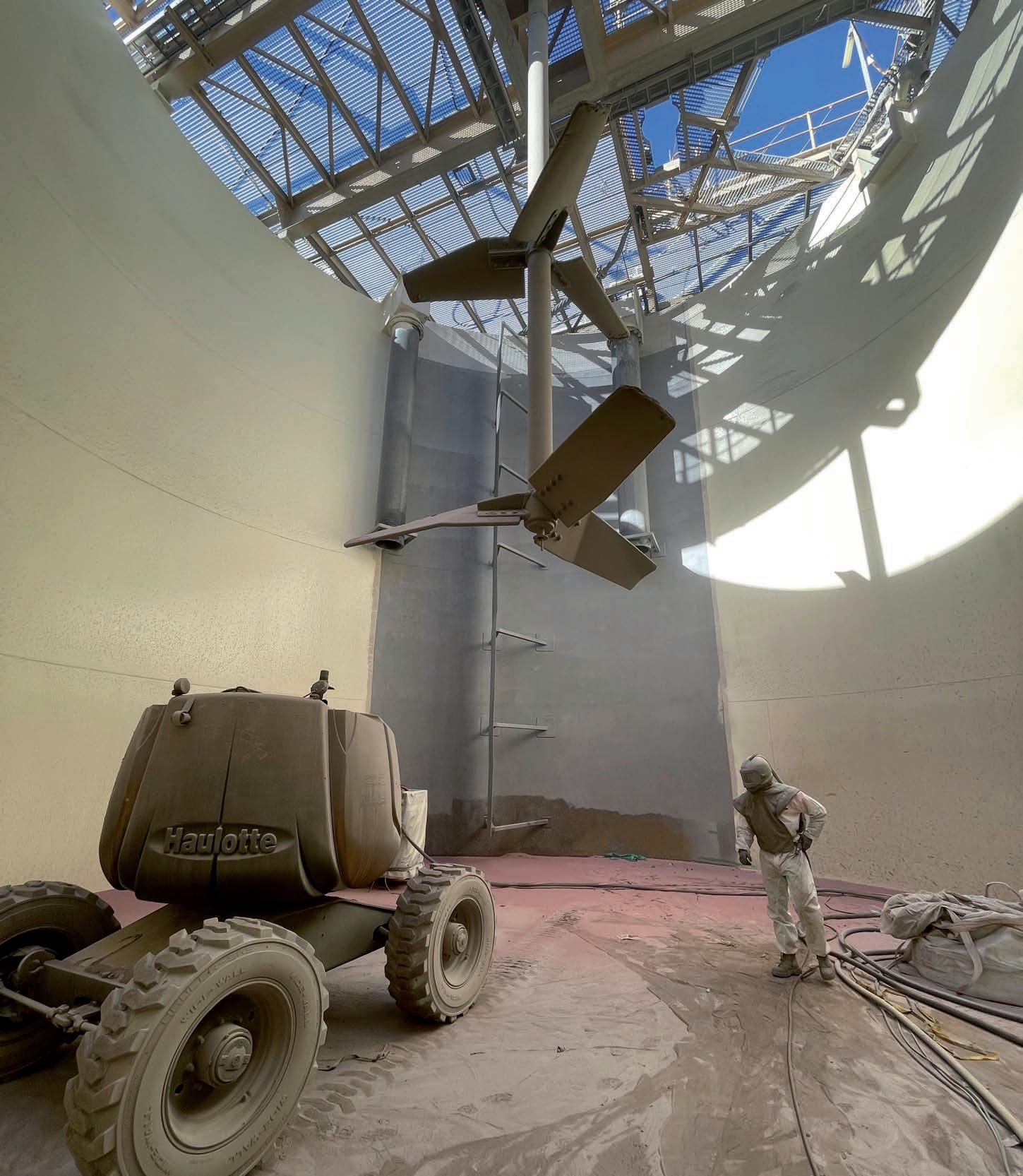
This includes Worley Group, which is undertaking the metallurgical and process engineering for the process plant test work program and mine engineering design.
Slurry pipeline specialist Fortin Pipelines is examining water and the direct-toport underground pipelines, the latter of which connects the project with Myponie Point. Port infrastructure expert Royal HaskoningDHV is examining port design.
Global environmental advisory firm SLR Consulting, as environmental impact statement (EIS) consultant, is leading environmental approvals in New South Wales and managing the project’s environmental approvals in South Australia.
Then there’s engineering group Australian Mine Design and Development (AMDAD), which is preparing a complete Hawsons Iron mine plan, including final pit design, mining sequence, implementation schedules, fleet composition, costings, pathways to net-zero emissions, and more.
Hawsons has also received a comprehensive report from Advisian, detailing the ideal energy balance to optimise the project’s ESG and sustainability outcomes.
This report sets out three decarbonisation pathways for Scope 1 and 2 emissions
abatement, the most comprehensive of which would enable Hawsons Iron to achieve net-zero emission status required for green steel production by 2035.
An advisory committee of specialists is ensuring the BFS is fit-for-purpose to secure funds to develop the world-class mine.
Committee members Nick Jukes, Genevieve Gregor and Richard Robinson bring decades of expertise in engineering, development and financing to enhance the success of the BFS.
Granzien said a compelling BFS would instil confidence in stakeholders such as banks, investors and potential offtake partners that the Hawsons Iron project can “achieve all the things we know it can”.

With every new announcement and milestone, Hawsons Iron adds to its narrative – the story of an inspired new approach to an age-old commodity that is just as pertinent as it is important.
Considered the world’s most important engineering and construction material, steel demand is set for further growth as the world decarbonises.
And in order to meet their net-zero targets, steelmakers will become more selective about the iron ore products they purchase.
To put it simply, the higher the grade the better, and with one of the highestgrade iron products on the seaborne market Hawsons Iron has an important role to play.

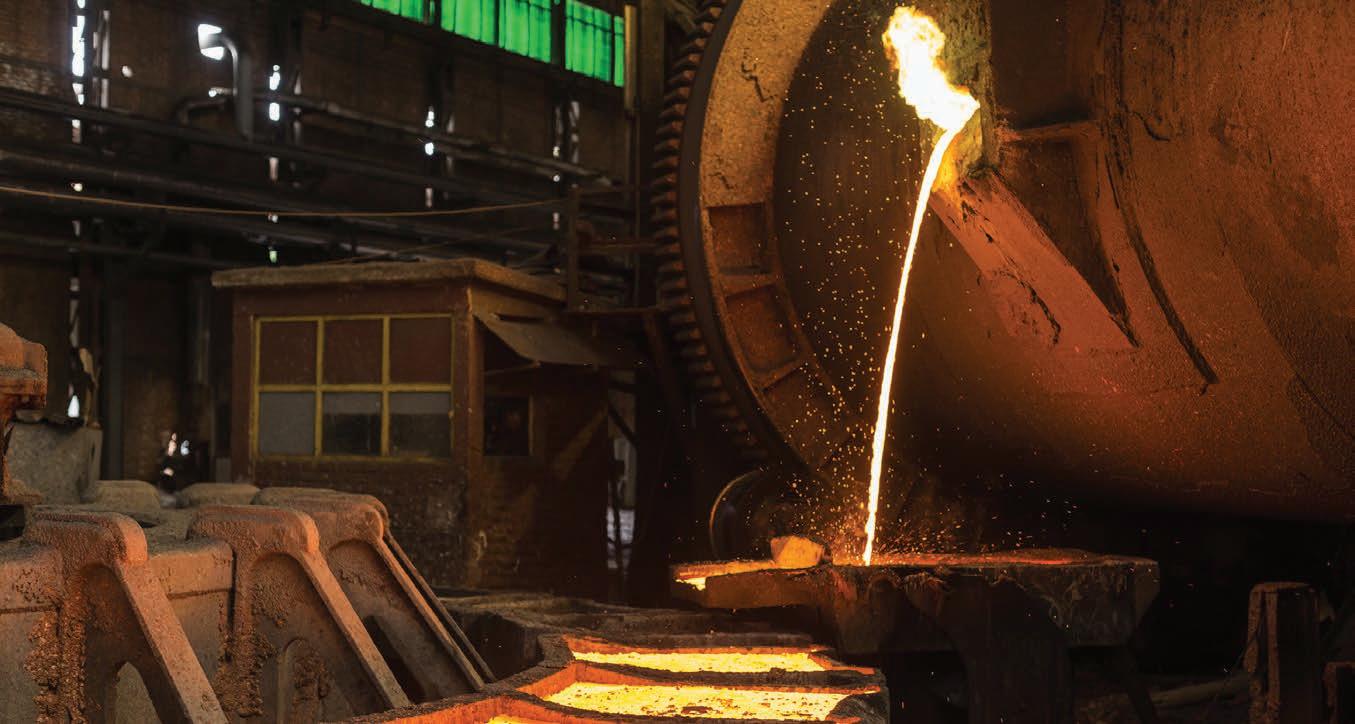
In the second of a two-part series, we explore the remaining two themes discussed in PwC’s ‘Mine 2022’ report: critical minerals and ESG.
Critical minerals are increasingly permeating the global mining and economic dialogue as the world’s pursuit of decarbonisation heats up.
Geoscience Australia defines a critical mineral as a metallic or non-metallic element that is essential to the functioning of our modern technologies, economies and national security, which is also at risk of experiencing supply chain disruption.

While the European Union (EU) published its first critical minerals list in 2011 –featuring 14 minerals on the bill – Australia didn’t debut its own list until 2019.
Today, the list features 26 minerals and Geoscience Australia provides data around each commodity’s geological potential in Australia, its demonstrated resources, and the local and global production levels.
Some of the most recognisable names on the list include lithium, cobalt, rare earth elements and vanadium, but one could be forgiven for never having heard of beryllium, bismuth, niobium and rhenium.
PricewaterhouseCoopers (PwC) believes critical minerals represent the most significant issue facing the global mining sector today.
This was highlighted in the firm’s recent ‘Mine 2022’ report, which examines the performance of the world’s top 40 mining companies in 2021, while unpacking the most urgent trends facing the global mining industry.
In the August issue of Australian Resources & Investment, we explored two of the four themes discussed in the report,
shining a light on the record-breaking financial performance of the world’s top miners in 2021 and examining the increased volume of mergers and acquisitions (M&As) in recent times.
In the second of a two-part series, we unpack the pressing concern that is critical minerals and investigate environmental, social and governance (ESG) – a concept that is growing in stature and will increasingly influence investor sentiment into the future.
Every year, PwC ranks the world’s top 40 mining companies through the aggregation of public information such as annual reports and financial reports available to shareholders.
The rankings also express PwC’s point of view on topics affecting the industry,
developed through interactions with its clients and other industry leaders.
Majors BHP, Rio Tinto and Vale maintained their grip at the top of the list –at one, two and three, respectively, in 2022 – while Glencore rose from eighth spot to fourth, overtaking Fortescue Metals Group in the process. Fortescue slumped from fourth to 10th, joining Newmont Corporation (seventh to eighth) and Russia’s MMC Norilsk Nickel (sixth to ninth) as sliders in the top 10.
Chinese coal miner China Shenhua Energy Company (fifth), US copper juggernaut Freeport-McRoRan (sixth) and Anglo American (seventh) made up the rest of the top 10.
The list demonstrates the global nature of the mining sector, with representation from 12 countries, including Switzerland, Mexico and Saudi Arabia. Newcrest Mining (25th)
Smelting is an important process in creating copper.Australia’s critical minerals list features 26 minerals, including lithium, cobalt and vanadium.
and South32 (26th) were the other Australian companies featured on the bill.
Critical minerals can be concisely construed by a brief definition but their influence is far greater than that. The global net-zero race is dependent on these minerals. Without lithium, cobalt and vanadium, electric vehicles (EVs) cannot be manufactured, while silicon and rare earths elements are vital for renewable power generation.
EVs, wind and solar energy underpin net-zero targets and if manufacturers don’t have sustainable access to critical minerals when the 2030s and 2050s come around, limiting the effects of climate change will be nigh on impossible.
“(Critical minerals is a pressing issue) on the back of that transition to a lowcarbon world, and the massive amount of investment that’s needed to support that,” PwC Australia partner Marc Upcroft told Australian Resources & Investment.

“When you look at the mineral content that’s needed to support that (transition), we’re talking about more, not less, minerals.
“And it’s becoming clear to us that if you’re trying to achieve the energy transition on the current target and timetable, this only happens if there’s a substantial increase in exploration, discovery, development and mining of critical minerals.”
Mine 2022 demonstrates that not only are critical minerals inherent resources to the manufacturing of batteries and
renewable energy infrastructure, but these green technologies are also more materialintensive.
“The production of a solar farm requires three times more mineral resources than a similar-sized coal plant and constructing a wind farm needs 13 times as much as a comparable gas-fired plant,” the report stated.
Mine 2022 estimated offshore wind power generation to require 15,409kg of critical minerals per megawatt of power, with onshore wind power generation necessitating 10,167kg of critical minerals per megawatt. In comparison, a natural gas plant requires 1166kg of critical minerals per megawatt.
Solar photovoltaic cells – the devices that convert sunlight into electricity – require 6834kg of critical minerals per megawatt, while a coal-fired plant needs 2485kg of critical minerals per megawatt.
There are expectations that lithium demand will rise from approximately 500,000 tonnes of lithium carbonate equivalent (LCE) in 2021 to between three and four million tonnes (Mt) in 2030.
According to S&P Global, demand for copper will nearly double to 50Mt by 2035, while demand will reach more than 53Mt by 2050 – estimated to be more than all the copper consumed globally between 1900 and 2021.
Furthermore, S&P Global forecasts a 10Mt copper shortfall in 2035.
“The energy transition is going to be dependent much more on copper than our
current energy system,” S&P Global vice chair Daniel Yergin said.
“There’s just been the assumption that copper and other minerals will be there ... copper is the metal of electrification, and electrification is much of what the energy transition is all about.”
According to a recent report from the Cobalt Institute, the cobalt market experienced 22 per cent growth in 2021 and this trend will continue to rise by about 13 per cent per year for the next five years.
The institute expects annual cobalt demand to approach 320,000 tonnes in the next five years, up from 175,000 tonnes in 2021, with 70 per cent of the growth to come from the EV sector.
EV-related cobalt demand overtook other battery applications in 2021 to become the largest end user of cobalt at 34 per cent of demand, totalling 59,000 tonnes.
And lithium, copper and cobalt make up only three of the critical minerals central to the renewable energy transition.
As miners and end users attempt to marry up their order books and timelines, commodity prices have been volatile – to say the least – in recent times. The supply–demand equation has been far from stable, a situation Upcroft expects to continue going forward.
“We want to have a stable environment for what is, in history, one of the most significant transitions we’ve ever seen in terms of the scale of change and the pace of change,” Upcroft said.
“When you look at the broader net-zero ambition that we have as a planet, and you consider specifically the energy transition, it’s impossible to see that scale of change when you look at the mineral component.
“(There’s) such large shifts in supply and demand of very large scale but (also) a bit of uncertain timing in amongst all of that as well.
“It’s impossible to see all that play out without that associated higher volatility in price.”
Upcroft believes that while people are aware of the climate ultimatum and what is required as a result, there is less clarity regarding the specific timing of renewable energy penetration and what this means for mineral demand.
“It’s about forecasting what’s going to happen and when,” Upcroft said.
“And “when” is probably the most critical piece because we all know what the end game looks like. If we fast forward to 2050, we know what that looks like in terms of EV penetration, renewable energy penetration, etcetera.

“It’s the timing around all of that and what that means for the increases in demand for minerals that have to somewhat marry up with what the supply for minerals can deliver.”
Linked to the pursuit for decarbonisation is the mining industry’s ESG responsibility, which also concerns the sector’s social
licence to operate and societal reputation.
PwC put it best.
“In all industries, the ESG revolution is upon us,” it said in Mine 2022. “Miners will see tangible business benefits by reorientating operations around a value proposition that puts people and planet alongside profit.
“As miners work to provide the minerals to achieve a net-zero future, the societal impact on communities and the broader ecosystem of stakeholders must be front of mind.”
PwC said ESG presents risks and opportunities for the top 40 mining companies.
Governments and regulators are sending clear signals that companies will be held accountable if they don’t operate in more sustainable and ethical ways.
Upcroft said the Australian mining industry has gone through a major ESG transition in recent years and that most Tier 1 miners were now well advanced in their ESG strategy.
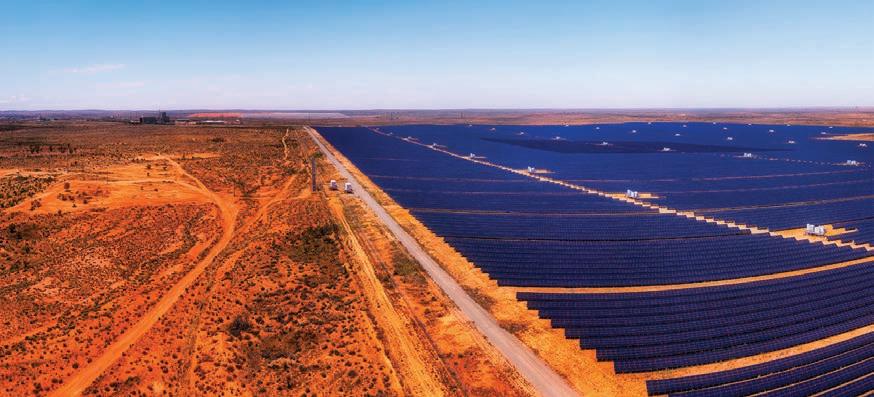
“Go back two or three years and ESG was more of an add-on to the mining company strategy rather than being an integral part of it,” he said.
“There’s still more to come from these larger miners and a lot of that’s focused on making the whole group strategy inclusive of ESG, so that ESG can become an equally important pillar for value creation.”
Upcroft said that while much of mining’s next tier was beginning to embrace ESG, there were still “laggards” in that space.
“The key feature (among that next tier) is that, corporately, ESG is still … an add-on to their existing strategies and operations
rather than an integral part,” he said.
“We expect to see the leaders in the ESG space – and the leaders in the mid-tier space – to be the ones who properly integrate ESG into their strategy rather than ignore it or bolt it on to what they’ve been doing previously.”
The mining industry can implement sustainable practices by providing materials
and mineral processing capacity for the renewable energy transition; however, this is not a “free kick” to being an ESGprogressive enterprise.
“Mining (companies) can’t really see their role in energy transition as a free kick on ESG, corporate trust and that social licence to operate,” Upcroft said. “To properly do well on that front, trust needs to be genuinely


earned and maintained.
“We’re all alert to the potential of greenwashing … these days, so I don’t think it’s going to be as easy a run as perhaps people thought it might be.
“And the importance of that is (the fact) solid ESG credentials are quickly becoming an entry point to raising debt and equity.
“You don’t have the time anymore to raise the equity, build the project and then over the next five to 10 years build your credentials and everything else. If it’s not there upfront, then you might not get your debt or equity. Or if you do, it’ll come at a higher cost.”
ESG could be the difference between closing a crucial loan or debt arrangement with a bank or winning over a major shareholder.
It may not be an attractive concept on paper, but it will underpin the future viability and prosperity of the mining industry, whether companies like it or not.
Silica is beholden to a complex global marketplace and precise-albeit-relativelysimple mining process. Australian Resources & Investment shines a light on emerging silica sand company Diatreme Resources.
In far north Queensland ¬– about 220km north of Cairns – lies the world’s largest silica sand mine.

Cape Flattery is owned by Mitsubishi Corporation, which ships roughly three million tonnes (Mt) of silica sand from the operation each year, bound for Japan and other parts of Asia.
Silica has traditionally been used in glass, foundry and chemical industries, but it has a growing profile in the renewable energy sector, where the commodity is important in the manufacture of photovoltaic cells in solar panels.
There are several emerging Australian companies looking to bring silica sand projects online in the coming years. Chief among these is Diatreme Resources, with its Galalar and Northern Resource projects located adjacent to Cape Flattery.
Galalar and Northern Resource are situated at the south and north of a single tenement, covering an extent of a large dune field which has been accumulating sand for millions of years.
A 2021 pre-feasibility study (PFS) indicates Galalar has a post-tax net-present value (NPV) of $358 million, an internal rate of return (IRR) of 66 per cent, and capital payback within 1.4 years.
Diatreme said Galalar had the potential to support the manufacture of 3.2 billion solar panels, the equivalent of taking 132 million cars off the road.
Diatreme inked a landmark agreement with global industrial minerals company Sibelco in late June.
Sibelco became a major Diatreme shareholder through a $13.97 million share placement, while Diatreme’s existing major shareholder Ilwella raised a further $3.3 million for the emerging miner.
Sibelco and Diatreme have also agreed to a joint venture to develop Galalar and Northern Resource, supported by a $35 million investment from Sibelco split across two tranches of $11 million and $24 million.
Diatreme chief executive officer Neil McIntyre said the Sibelco partnership was “transformational” for the company.

“Sibelco is one of the world’s largest industrial minerals companies,” McIntyre told Australian Resources & Investment
“The company is European headquartered but has worldwide operations and, particularly in the silica space and high-end silica, Sibelco is a world leader.
“There’s no company that understands the silica market better.”
McIntyre said the agreement with Sibelco is made more significant by the fact silica projects aren’t straightforward for emerging miners.
“The struggle for a junior in transitioning from exploration into pre-development and development,
particularly in industrial minerals, is (the fact) getting genuine offtake in place with major manufacturers is very difficult,” he said. “Particularly in high-purity silica because you’re mining and selling a product almost at a chemical grade.
“The specifications for this product are so fine – down to parts per million – and as a start-up the end users look at you somewhat sceptically regarding your ability to deliver the quality of product they need.”
For glass manufacturers producing on continuous batching processes, incorrect silica specifications (impurities) can lead to glass bubbling and other issues, which can ruin the product altogether. The ramifications can be more severe than an errant piece of glass, with a company’s industry standing on the line.
“Manufacturers are hypersensitive about their reputation and their ability to be able to deliver the products they need,” McIntyre said.
McIntyre said while the silica market has a long history, it lacks the transparency of other commodity markets and has traditionally been difficult to understand.
But that’s changing.
“Traditionally, a lot of the silica market in Australia has been dominated by trading houses – Japanese trading houses, in particular,” McIntyre said. “Mitsubishi is one of them and there are two or three others out of Western Australia that dominate that market.
“This creates a market that’s incredibly opaque and you can’t easily see the substance behind it in terms of pricing and in terms of the products they’re producing.
“So what we’re seeing is a level of maturity coming into the silica market now, with a number of listed companies like us. There’s about three or four in Western Australia.
“We’re a public company, we publish and talk about everything to do with our business, and that’s new.”
As part of the Sibelco partnership, McIntyre said Diatreme will continue to manage the day-today on-ground matters, including exploration, permitting approvals, engagement with Traditional Owners and government.
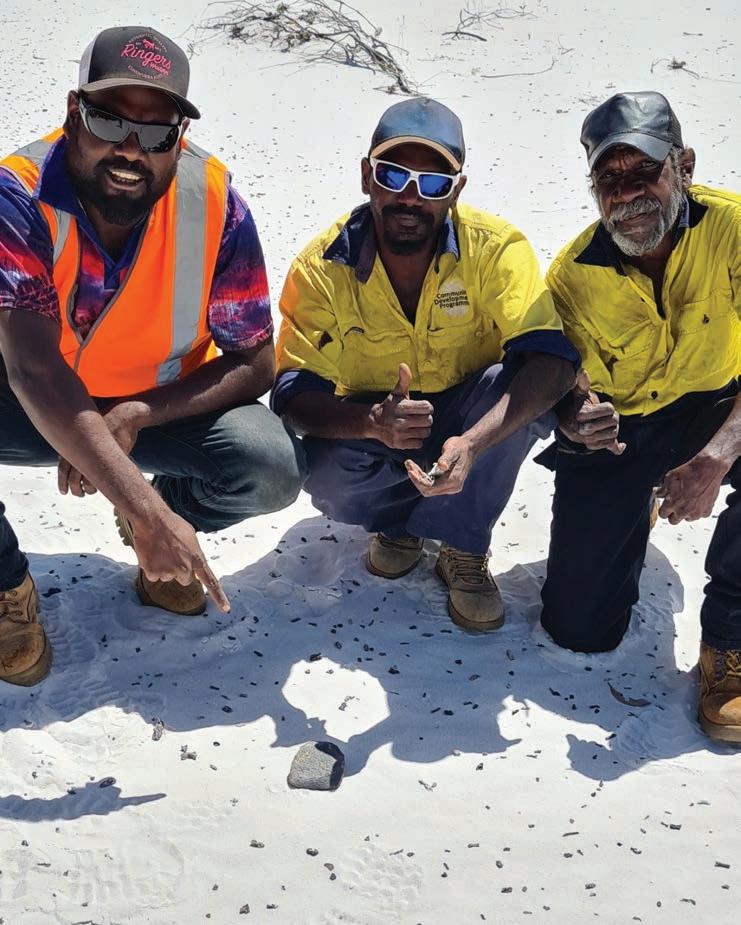
Sibelco will enable Diatreme access to its network of specialist processing technology, expertise, and 150 years’ worth of experience in silica sand.
McIntyre said this would be critical in establishing future offtake agreements, as Sibelco understands how to develop a supply chain and what buyers want.
“In many ways, it’s a great marriage of the offshore, technical and market understanding married up with the domestic, deep understanding of the resource,” he said.
Diatreme aims to complete its Galalar bankable feasibility study (BFS) and lodge its environmental studies by early 2023.
The company aims to complete permitting and approvals by late 2023, before Galalar production begins in 2024.
Diatreme established an MoU with Far North Queensland Ports Corporation in August to support its Northern Resource project. The MoU outlines key terms of cooperation in advancing exports from Northern Resource via the Cape Flattery port.
The company also lodged two mining lease applications (MLAs), as well as four infrastructure MLAs for Northern Resource, which McIntyre said was the first step in opening this project to potential export development activity.
Diatreme will continue resource drilling at Northern Resource to upgrade resource categories and further understand the tenure.
With a PFS and BFS still to be completed for Northern Resource, McIntyre said it was about 18 months behind Galalar.
But that doesn’t mean it isn’t impressive.
“While they are separate and distinct projects, the advantage of the northern project (Northern Resource) is we believe it’s probably of a larger scale than the southern project (Galalar),” McIntyre said.
“If we’re looking at potentially about 1.3 million tonnes of exported product from the south, we’ve probably got two to three million tonnes from the northern project subject to, of course, further proof through resource drilling and higher categories in the resource.
“We think the north has much larger potential, so it would be an important addition moving forward as we aspirationally aim for three to five million tonnes of production within five years, subject to advancement through permitting and approvals processes.”
The Diggers & Dealers Mining Forum took place in Kalgoorlie in August. Australian Resources & Investment explores the key themes to emerge from the revered conference.
The 2022 Diggers & Dealers program was jam-packed with big names, with the likes of BHP, Fortescue Metals Group, Newcrest Mining, Agnico Eagle, and many more presenting at the three-day event.
Some presentations were more circumspect than others, with a few companies content to stay in their lane, but there were enough scoops for the attentive journalists who were looking for them.
Given Diggers & Dealers takes place in Kalgoorlie, in the heart of the WA Goldfields, the precious metal’s future was a key theme of the conference.
Battery metals was another prevailing subject across the three days, while many junior miners also had the opportunity to strut their stuff before an interested investor audience.
Australian Resources & Investment unpacks the key ideas to emerge from this year’s Diggers & Dealers.
Diggers & Dealers’ gold mining contingent was represented by Newcrest Mining, Agnico Eagle, Northern Star Resources, Genesis Minerals, Capricorn Metals, Bellevue Gold, Calidus Resources and more.
In fact, at least 19 gold mining companies presented at the conference, with organisations brandishing projects of varying maturation and sizes.
Newcrest used its presentation at Diggers & Dealers to voice its desire for new gold exploration opportunities.
“Exploration is a team sport, it’s not just something that one company can do on its own,” Newcrest general manager for exploration Fraser MacCorquodale said on the first day of the conference.
On the lookout for potential gold partners at Diggers & Dealers, MacCorquodale said Newcrest could bring more than 40 years of exploration experience and transactional flexibility to a joint venture (JV).
He said the company was agile, able to quickly complete a transaction, and had “experience in quickly transforming opportunities into long-term mines”.
MacCorquodale said the Havieron project in WA, which Newcrest shares in a 70:30 JV with Greatland Gold, was an example of the company’s exploration credentials.
Havieron has been an undoubted success story since the two companies inked a fourstage farm-in agreement to explore the project in March 2019.
This materialised into a fully-termed JV agreement in November 2020, and Newcrest and Greatland Gold have since achieved milestone after milestone.
Greatland Gold recently reported a $US1 billion increase in Havieron’s net-present value (NPV).
The project is valued at $US1.2 billion as at December 2021. When stage one of the Havieron pre-feasibility study (PFS) was released two months prior, Havieron was worth $US228 million.
Such is Havieron’s appeal, Andrew Forrest’s Wyloo Metals recently bought into Greatland Gold via a two-tranche, $120 million investment. The investment comprises an initial $60 million equity subscription, which is subject to shareholder approval, with a potential $60 million to follow.
Wyloo will become Greatland Gold’s largest shareholder following the investment, owning approximately 8.6 per cent of the gold company.
One of the most anticipated presentations of Diggers & Dealers 2022 was Genesis Minerals, with attendees waiting with bated breath for an update on its deal talks with St Barbara.
Genesis managing director Raleigh Finlayson obliged, to some extent, highlighting that the two companies, which both have significant footprints in the Leonora gold region of WA, married up nicely.
“Having done extensive DD (due diligence) on each other’s assets, we can see operational synergies that can pair the right rocks with the right mills, the right skills with the right minds and provide operational levers to de-risk assets to the benefit of shareholders,” he said.

Finlayson said the companies were exploring ways of “differing but ultimately eliminating material capex (capital expenditure)” in an inflationary cost environment not seen since the 1980s.
Finlayson’s message was that the company had the resources to progress discussions at its own pace.
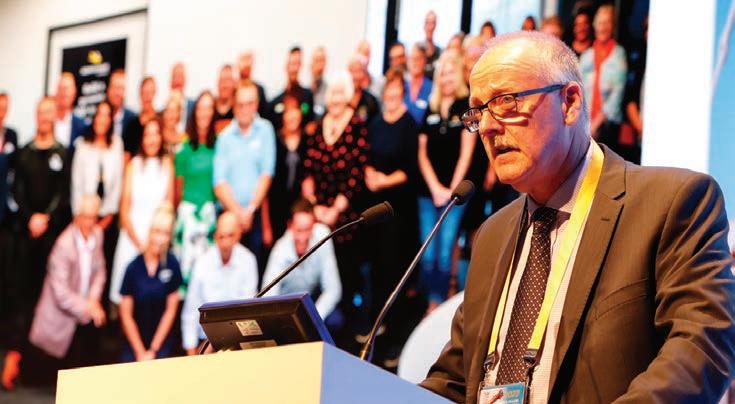
“We have time and capital, we’ve got over $100 million in our bank accounts and if we take into consideration the money options, that’s $150 million of money on our balance sheet,” Finlayson said. “We have optionality as I’ve articulated, but ... we’ll remain patient and disciplined on our overarching five-year strategy which we’re only four months into.”
St Barbara was also represented at Diggers & Dealers, with the company’s chief financial officer Lucas Welsh making a presentation.
Welsh didn’t mention anything specifically about St Barbara’s ongoing discussions with Genesis, but he did highlight the company’s significant landholding and presence in the Leonora region, suggesting it would be central to any consolidation in this gold mining district.
Both Genesis and St Barbara have shown their proclivity for mergers and acquisitions (M&A) in recent times, having acquired Dacian Gold and Bardoc Gold, respectively, in 2022.
When this feature was written (September 20) there had been no update on deal talks between Genesis and St Barbara.
Another keen M&A player at Diggers & Dealers was Gold Road Resources, which recently acquired DGO Gold and its 14.4 per cent stake in De Grey Mining along with it. Gold Road managing director Duncan Gibbs said the company, which owns half of the Gruyere gold
mine in WA with South Africa’s Gold Fields, is open to further bolstering its portfolio.
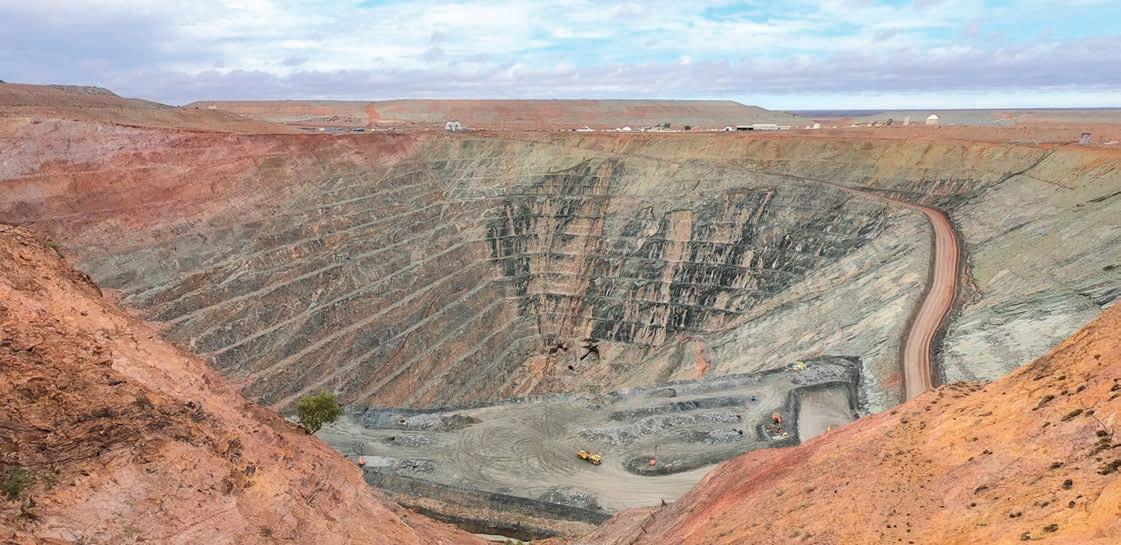
“We’re happy to play in kind of any space, so we’re certainly able to look at projects in that advanced exploration, development (phase),” he said. “You know, first prize is probably an operating asset, but everybody else is looking for those and, you know, it’s generally hard to see value.”
Gold Road’s shareholding in De Grey just got a lot sweeter after the latter company added an extra 2.1 million ounces (Moz) of potential gold production to its fancied Mallina project in WA.
A Mallina pre-feasibility study released in September demonstrated the potential for 6.4Moz of gold to be produced across a 13.6year mine life. A 2021 Mallina scoping study indicated a 4.3Moz production profile across the life of mine.
Diggers & Dealers attendees received an update on Agnico Eagle’s recently acquired Fosterville gold operation in Victoria (through its purchase of Kirkland Lake Gold), with vice president of corporate affairs (Australia) John Landmark demonstrating the company’s exploration efforts at the mine.
Landmark said the Canadian-based gold miner was investing $US60 million ($89.2 million) in exploring Fosterville in 2022, with the hope of achieving 200,000m of diamond drilling.
“(In July), we completed the twin decline drives across to Robbins Hill,” Landmark said. “In putting this drive across – it’s a twin drive which is nearly 5km long – we did that 10km of driving in just over two-and-a-half years.
“We’re now in a position to put seven drill rigs underground to define Robbins Hill. So we’ll be doing that over the next couple of years.”
Located 4km north of the existing Fosterville mine, the Robbins Hill deposit has the potential to become the project’s second mining operation. Landmark said Robbins Hill had 3km of down-plunge mineralisation.
It’s not all gold in the Goldfields, with the WA region playing an important role in supplying the renewable energy transition.
BHP used its presentation at Diggers & Dealers to reinforce its commitment to its Nickel West operations in the northern Goldfields.
Nickel West president Jessica Farrell said the major miner planned to spend more on exploration at the operations in 2022 than it has in any other year.

“To underscore this point, this year will be the highest annual spend for exploration in Nickel West since BHP acquired the WMC (Resources) assets in 2005, a testament to the focus and commitment BHP has to its nickel business right now,” she said.
With 75,000 hectares of exploration potential within the Agnew–Wiluna greenstone belt, BHP plans to spend more than $140 million on brownfield exploration in the next two years to further understand the tenure.
“We have a large nickel sulphide resource with in excess of 7.4 million tonnes of nickel in the Agnew–Wiluna belt that still remains largely unexplored,” Farrell said.
“This is a highly prospective strip, approximately 150km long … and has a number of deposits that we are looking to understand further and potentially mine.”
BHP expects three out of five passenger car sales to be electric by 2030, before rising to nine out of 10 by 2040.
And with nickel proving to be an important component of the batteries that power electric vehicles (EV), BHP’s lowest plausible case foresees a doubling of nickel demand in the next 30 years.
Lynas Rare Earths Australia’s sole rare earths producer, Lynas Rare Earths, also presented at Diggers & Dealers, with managing director and chief executive officer Amanda Lacaze delivering an entertaining insight into the company.
The presentation coincided with Lynas announcing a $500 million project to expand capacity at its Mt Weld mine and concentration plant in the Goldfields.
Lynas’ expansion plans start with increasing Mt Weld’s feedstock capacity from 7000 tonnes per annum (tpa) to 12,000tpa of neodymiumpraseodymium (NdPr) equivalent in 2024.
The company’s 2025 growth plans, which were announced in May 2019, targeted 10,500tpa by 2025.
Lacaze said there was potential for a greater production boost, too.
“Two additional stages still in development will target an additional 4800tpa,” she said at Diggers & Dealers. “As we move further into the orebody and down the grade curve and into new mineralogies, we will begin increasing throughput from 0.3 million tonnes per annum to 1.3 million tonnes per annum, and that gives us sufficient headroom to continue to grow.”
Lacaze said the expansion would enable Lynas to improve Mt Weld’s sustainability profile, with a high recovery water recycling circuit planned for the operation.
Lynas will also transition Mt Weld’s power from diesel generation to a gas hybrid renewable solution. The $500 million project is fully scoped and funded from Lynas cash flow.
Lacaze said a rare earths deficit was looming, and that China had gained control of the market.
“Demand for magnetic materials is forecast to double by 2030,” she said. “But this demand is within a market which is structurally illequipped to meet the increased demand.
“Over the past 30 years, China has become dominant in many minerals processing and manufacturing sectors and there is nowhere where this is more evident than rare earths.
“In a nutshell, China has leveraged its resource and processing knowhow to develop a dominant position in the supply of essential materials for green future-facing industries.”
IGO’s nickel assets include the Nova, Forrestania and Cosmos operations in WA.Lynas managing director and chief executive officer Amanda Lacaze at Diggers & Dealers 2022.
Nova has been a star player for IGO in recent years and delivered another strong performance in the 2021–22 financial year (FY22), producing 26,675 tonnes of nickel (FY22 guidance: 25,000–27,000 tonnes).
IGO achieved cash costs of $1.95 per payable pound (lb) of nickel in FY22, which fell below targeted costs of $2.00–2.40/lb despite the inflationary pressures currently affecting the Australian mining industry.

IGO managing director and chief executive officer Peter Bradford said the company was
attempting to transfer its Nova expertise to its other recently acquired assets.

“We’re … looking at ways we can take some of those learnings at Nova and transfer those into the new assets at Cosmos and Forrestania, as well as looking for ways we can get operating synergies across the three mines,” he said at Diggers & Dealers.
Bradford said IGO was also carrying out a “systematic review” of Forrestania’s tenements. This includes exploring the potential of the operation’s Flying Fox and Spotted Quoll mines.
This could include additional nickel, lithium and gold resources.
IGO is targeting first production at Cosmos in mid-2023, which is later than what was advertised by previous owner Western Areas.
“We’ve adopted a different plan, a different strategy for how we (will) bring the operation through development,” he said.

“We’ve reset everything around when the shaft will be completed and that’s going to be completed about the middle of next year.
“So that buys us more time to invest more money in the processing infrastructure –expand that beyond the 750,000 tonnes per annum envisaged by Western Areas to lock in 1.1 million tonnes per annum.
“And it buys us more time to open up multiple areas underground so that when we do start production, we can … substantially fill the mill at that time.”
Whether it was gold, nickel, rare earths, lithium or copper, or anything else, many compelling insights came from Diggers & Dealers 2022.
But while battery metals will be increasingly sought-after amid a strengthening renewable energy transition, it’s clear gold isn’t going anywhere just yet.

Rich with nickel and lithium resources, the Goldfields region of Western Australia will become increasingly important in the green energy transition. And Duratec will support the region every step of the way.
The Australian resources sector has been an integral part of Duratec’s success since its inception in 2010, and the ASX-listed company has established a particularly strong presence in the Goldfields region of Western Australia.
The often-harsh environments of the mining industry mean infrastructure is subject to corrosion, and Duratec’s team of engineers specialises in the protection and remediation of steel and concrete.
Duratec supports a range of commodities in the Goldfields, including gold, nickel and lithium, with much of its remediation work stemming from existing mines rather than capital expenditure (capex) projects.

“More than 95 per cent of what we do is maintenance, where the operation takes things offline or there is a shutdown, and there is time pressure,” Duratec general manager Chris Oates told Australian Resources & Investment
Duratec project manager Carl Klem said its mining clients were often reactive to infrastructure concerns and, given miners have strict KPIs, downtime needs to be limited.
This means Duratec must respond quickly and efficiently.
“When a plant is offline, mining companies or contractors can lose significant money,” Klem said. “They don’t have redundancies to take tanks out of a circuit and still operate at an optimal rate.
“So our work is time-critical and often involves a lot of on-the-spot problem solving. Half the time we walk into situations where we’re not aware of the full scope of work.”
Klem said Duratec may be engaged to fix one issue, but there will often be other concerns that must be rectified as well.
“We might have been tasked to paint inside a tank, but once we arrive we find that the floor needs to be cut out and repaired, and other issues could be present.
And we have to do this quickly so the client can get the tank back online.
“There’s a regular set of challenges for us in the Goldfields. We go into these jobs prepared to see the worst, and most of the time we’ll see what we expect to see.”
Duratec was engaged by a third party to complete internal and external coating works on a tank at St Barbara’s Leonora gold operations in the Goldfields.
Having successfully restored the tank through blasting and painting its internal walls, Duratec was awarded a truck stop remediation project and various structural blast and paint works around site.
Duratec has also worked with BHP at its Nickel West operations in the Goldfields, where the contractor was tasked with restoring a deteriorated acid bund.
The company installed 1200 square metres of acid-proof coatings and 400 square metres of acid bricks, equating to 17,000 acid bricks and 30,000kg of products installed.
Duratec received positive feedback from BHP, along with high safety achievement recognition.

Oates sees a bright future for the Goldfields and for Duratec’s work in the region, with the demand for battery metals, such as nickel, set to exponentially grow.
This will result in more battery metals projects and a greater need for remediation works.
Oates said Duratec grew 30–40 per cent more in the 2021–22 financial year (FY22) compared to FY21 and expects the company to be active in the Goldfields “as long as gold’s being made and nickel’s being made”.

“The future for Kalgoorlie and all mining is pretty strong,” he said. “If you look at it from a macro level, where’s the world heading?
“We know EVs (electric vehicles), battery and energy storage are going to become more and more prominent, and if you look at that more closely, commodities such as cobalt, nickel and lithium are going to become more important – these are abundant in WA.
“Considering the Russia–Ukraine conflict, manufacturers are realising we need more homegrown materials. That plays right into the favour of Kalgoorlie and Duratec.”
Duratec generated $310 million of revenue in FY22 – a sizeable jump from the $235.7 million earned in FY21.
The company also enjoyed increases in its EBITDA (earnings
before interest, taxes, depreciation, and amortisation) and NPAT (net profit after tax) year-on-year and expects its revenue and NPAT to increase again in FY23 with more than $700 million worth of active tenders.
While Duratec’s investors are in favour of mining, they are also cautious of the sector given commodity prices can experience volatile highs and lows.
Oates said that as the company further bolsters its investor base, accurate messaging is more important than ever.
“Mining is generally a capex environment,” Oates said.
“But we’re not linked to capex, we’re linked to maintenance. And this is what we tell our investors.
“As Duratec consistently grows its presence in the mining industry, we’re not suffering the highs and lows associated with capex.”
Oates said even if a commodity increases or decreases in price, a mining company must always maintain its assets.
“When that tank drops, you’re going to give us a call and we’re going to fix it no matter what the price of gold is,” he said.
“So what do our investors look for? We’ve got exposure to mining and we’ve got exposure to defence, which has been consistent over 10 years and has a massive pipeline.
“We’ve also got exposure to building and facades, as well as all other existing infrastructure such as wharfs, ports and holding tanks, etcetera.”
Duratec also supports other industries such as oil and gas, transport, marine, industrial and property services, meaning the company can draw on many different economic avenues.
And given the Goldfields will become increasingly important in the green energy transition, Duratec has a bright future in the region and the broader Australian mining industry.
A range of factors are set to dampen Australia’s iron ore export earnings, including reduced prices.
Central purchasing and a slowing Chinese housing market could have major effects on Australian iron ore producers – and beyond.
China has been Australia’s top consumer of iron ore for decades, accounting for 80 per cent of our exports of the mineral in 2021.
Export revenue has delivered longstanding profits to Australian miners and boosted the country’s tax revenue. However, Australia’s iron ore profits are threatened with the recent development of the China Mineral Resources Group (CMRG), set to act as China’s central iron ore purchaser.
This central purchasing power is designed to control demand and enhance Chinese steel producers’ negotiating power over prices. As the expected principal Chinese channel for buying imported iron ore from international third parties, the CMRG also assumes responsibility for raw material supplies to China’s steel industry, which absorbs approximately 70 per cent of global production, largely from Australia.
The formation of the CMRG, in combination with the recent weakness in China’s residential property sector, is set to place downward pressure on prices and dampen Australia’s iron ore export earnings, projected to fall from $133 billion in 2021–22 to $116 billion in 2022–23, and by a further $85 billion by 2023–24.
The establishment of CMRG stems from the retaliation of China’s Iron and Steel Association (CISA) against a perceived iron ore producers’ cartel. The push for centralised buying is in response to a period of high iron ore prices, which hit a record $US240 per tonne (t) in May 2021, delivering significant profits to a set of concentrated iron ore majors, whose production costs at the time were less than $US15/t.
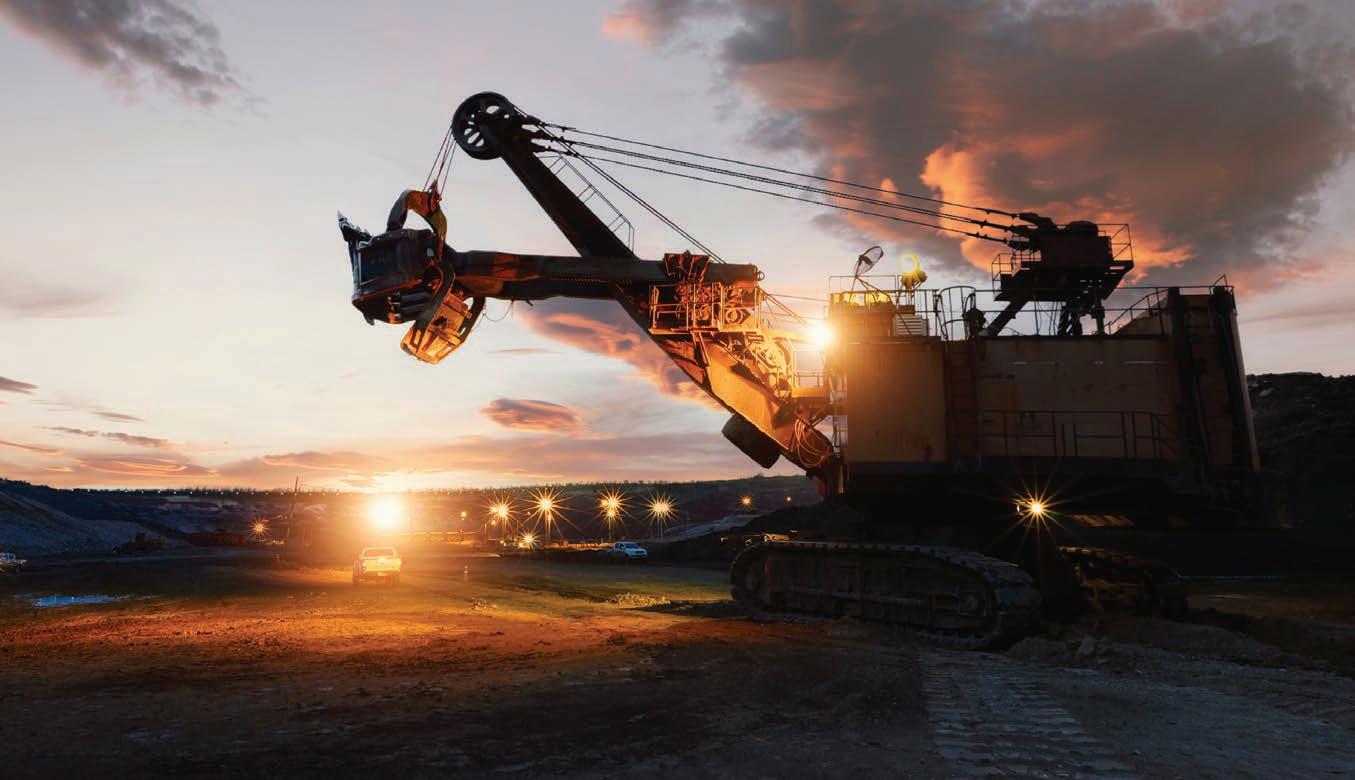
The threat to Australia’s iron ore demand is further exacerbated by China’s objective to reduce steel production in line with its goal of cutting carbon emissions.
This central purchasing program is part of China’s wider strategy to achieve 45 per cent iron ore ‘self-sufficiency’ by 2025, demonstrating a determination to wean itself off Australia’s iron ore. China’s senior government officials set a goal to boost domestic iron ore production by 30 per cent, increase investments in overseas mines, and strengthen scrap steel recycling.
But domestic production of Chinese iron ore isn’t the real problem for Australia. China’s ore grades are far lower than Australia’s and expanding its output will also increase carbon emissions, which will be counterproductive to emission targets.
While China’s steel industry will likely always need Australian iron ore, the country’s attempt to shake up the global iron ore market will have obvious ramifications for Australian exporters.
The world’s four biggest suppliers of seaborne iron ore – Rio Tinto, BHP, Fortescue Metals and Brazil’s Vale – account for approximately 70 per cent of global trade and 80 per cent of China’s imports.
But Australia’s big iron ore players, for their part, are not demonstrating any signs of public panic, arguing that supply and demand are more prominent drivers of commodity prices.
Is Australia being too complacent?
At worst, China’s newly formed central agency could decide to favour nonAustralian suppliers.
In fact, iron ore isn’t the only commodity at threat. China has already established informal central purchasing groups like large state-owned oil refiners who collectively buy crude oil or copper. As such, it seems very likely China will apply this type of structure to additional critical resources in the future, particularly if the CMRG proves successful.
The other critical factor threatening Australia’s iron ore profits is China’s sluggish gross domestic product (GDP), which grew just 0.4 per cent in the second quarter of 2022, largely as a result of extensive lockdowns as part of its COVIDzero response to the pandemic.
In September, the south-western Chinese metropolis of Chengdu announced a lockdown of its 21.2 million residents for citywide COVID testing. Other major cities are simultaneously tightening restrictions, ranging from work-from-home requirements to the closure of entertainment businesses in some districts.
While there has been a small rebound in activity as lockdowns ease over time, the economy will need to grow by 8.5 per cent in the second half of the calendar year to reach the nation’s 2022 GDP target of 5.5 per cent –a highly unlikely outcome.
According to the World Economic Forum, every percentage point decline in China’s GDP results in a 0.3 per cent reduction in global GDP.
In contrast to other major economies, China has been reducing interest rates to counter the economic impacts of its
COVID-zero policy, high debt challenges, weak income growth and, importantly, the property crisis.
While China enjoyed growth in the property sector since the early 2000s before reaching a peak in 2018, hundreds of thousands of home-buyers are now refusing to pay mortgages for pre-sold properties as developers struggle to complete housing projects on time. In fact, Chinese developers have only delivered 60 per cent of homes they presold between 2013 and 2020, and Chinese mortgage debt grew by $US4 trillion over the same period.
There are three key reasons buyers are striking on mortgage repayments. First, there are concerns property developers such as Evergrande will head into administration before projects are completed. Second, there is a possibility of financial destabilisation of the banking sector that is at risk of mass loan defaults. Lastly, the recent plummet in housing value suggests properties are likely to be worth less than what consumers originally purchased them for.
These factors strike parallels with the financial unrest in the lead up to the global
The CMRG is part of China’s strategy to achieve 45 per cent iron ore ‘selfsufficiency’ by 2025.
financial crisis and should therefore be a cause for concern.
The liquidity crisis stemming from the property sector, which accounts for approximately 30 per cent of China’s steel demand, is squeezing profits from Australia’s large miners, sending iron ore stocks into a bear market amid falling demand and rising costs.

More broadly, the impact of this property crisis is likely to impact Australia’s terms of trade.
Since 2005, Australia’s terms of trade (the ratio between the index of export to import prices) has been on the incline, largely catalysed by China’s accelerating demand for resources, while the cost of Australia’s manufactured imports has been simultaneously falling. As a result, every tonne of Australian exports was buying a greater value of imports.
However, with China’s GDP growth well off their target, a return to the longrun average for the terms of trade could affect $250 billion of Australia’s national annual income, with implications for government budgets and Australian living standards.
Adapting old mine sites to generate clean energy has long-term benefits for companies, communities and the environment.
Mine-closure planning traditionally focuses on reducing a site’s environmental liability, with the goal of restoring the landscape as close as possible to its pre-mining status.
But what is less considered is the potential for mine-closure planning to create long-term benefits by constructing renewable energy assets on old sites.
“Renewable energy is an exciting opportunity to explore in mine-closure planning,” SRK Consulting principal consultant – mine closure Danielle Kyan said. “It’s early days, but there are
more conversations underway about the potential for construction of renewable assets on old mine sites.”
Kyan emphasised, however, that renewable assets may not be feasible on all mine sites.
“The key is to be open-minded and ask questions about renewables early in the mine-closure planning process,” she said. “The projects are emerging.”
A key example is the former Kidston gold mine, about 275km north-west of Townsville in Queensland. Once home to Australia’s largest open-cut gold mine, the project closed in 2001 after 90 years of operation.

Genex, a power company, is now transforming the site into a cleanenergy hub by combining solar, wind and pumped-storage hydro power. This landmark conversion of a disused gold mine will generate enough electricity to power 143,000 homes for eight hours –and is expected to create at least 500 jobs during construction.
The Kidston Pumped Storage Project essentially turns the mine’s massive opencut pits into a giant battery by pumping water into an upper energy-storage reservoir when energy prices are low. It then releases the water through reversible turbines into
the lower reservoir to generate power when energy demand is high.
The facility will store energy from an operational 50 megawatt (MW) solar farm, as well as a planned 150MW wind farm due for completion in 2024.
At the Muswellbrook coal mine in the upper region of the Hunter Valley, New South Wales, planning is underway to transform Australia’s oldest open-cut coal mine into a major renewables precinct.
In addition to a pumped hydro project, there is potential to add solar, battery storage and green hydrogen facilities to the mix.
Kyan expects more mine closures in Australia this decade to involve the construction of renewable infrastructure.
“Some mines suit wind, solar, hydroelectric, geothermal or other renewable assets,” she said.
“The mines are typically on large, cleared areas of land, have been used for industrial purposes, and have existing infrastructure and a potential workforce.”
Many mining companies already use renewable technologies.
“We see a number of mines in remote areas installing renewable energy grids to power their sites,” Kyan said. “They’re using renewables in an operational capacity to reduce the project’s carbon footprint.

“The next step is exploring renewables in mine-closure planning strategy to create new opportunities.”
Kyan says building renewable energy assets on old mine sites potentially has longterm benefits for companies, communities and the environment.
“Mine closure has always been thought of as a cost,” Kyan said. “Renewables can provide an opportunity to develop new income from disused sites.
“That could change how we think about and fund mine-closure.”
There are also opportunities for mining companies to collaborate with energy companies on developing renewable
clean-energy projects. The Muswellbrook Pumped Hydro project, for example, is a joint venture between AGL and Idemitsu Australia Resources.
Current projects have benefited from government collaboration and grants. The Australian Renewable Energy Agency (ARENA) provided $47 million of funding for the Kidston project.
“Federal and state governments are showing significant interest in creating renewable energy precincts around old mining sites – and providing some funding for feasibility studies,” Kyan said.
Renewable projects on old sites create jobs, and in coal and other fossil fuel sectors, job losses are expected in coming decades as the world transitions to clean energy.
“When a mine closes, some of that site’s skilled workforce could be used in the construction and operation of a renewable asset, providing communities with options post mining,” Kyan said.
“That’s a much better outcome than a mining town losing a big part of its workforce when the mine closes.”
Greater energy security for communities is another positive.
“A new renewable energy project on an old mine site could help power homes in the region, as the Kidston project will do in far north Queensland,” Kyan said.
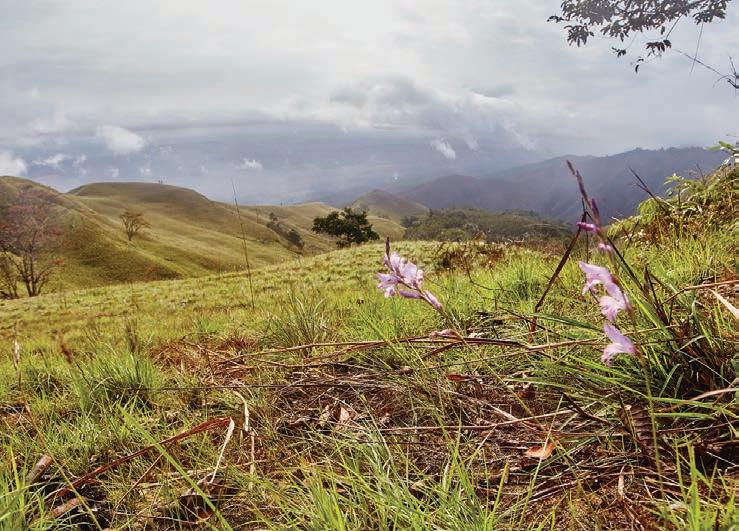
“This is particularly important in remote areas where the reliability of energy supply is an issue.”
Renewable projects at old sites have two main environmental benefits: first, providing a revenue stream for mining companies to invest back into mine-closure mitigation measures and ongoing land rehabilitation; second, the asset adds renewables to the energy mix, reducing reliance on fossil fuels.
“It’s a way for the global mining industry to play a bigger role in climate-change mitigation and adaptation,” Kyan said.
“This issue is ultimately about a social licence to operate. Imagine if we can take a mine that produced coal or another commodity for decades and help it become part of a clean energy precinct.
1. Start early: Consider the potential of renewable energy assets within mineclosure strategy. Encourage your board and management to ask questions about renewables within closure planning.
2. Be realistic: Construction of renewables may not be feasible in many mine closures. Much depends on the mine’s location and proximity to other energy infrastructure, the nature of the mine, and whether it suits various forms of renewables.
3. View renewables as complementary: The core task of mine-closure planning is to restore the environment as close as possible to its pre-mining status. Renewable assets from mine closures should be viewed as an additional benefit for companies and communities, not a substitute for the main environmental goals of mine closure.
Plans are in place to turn Australia’s oldest open-cut coal mine into a major renewables precinct.
“The disused mine wouldn’t just be an environmental liability to manage. Through renewables, we could start to think of it also as an asset.”
SRK Consulting is a leading, independent international consultancy that advises clients mainly in the earth
4. Invest in research: Understand whether your mine site is amenable to solar, wind, hydro or other forms of renewable energy, and assess the feasibility of transmitting that energy to nearby communities through the energy grid. Analysis of any environmental implications of renewable infrastructure on the site is also needed.
5. Understand the regulatory/ industry landscape: Identify if your mine is in, or near, a region that government has deemed to become a renewable energy hub. Assess the availability of government grants to research building renewable assets. Determine companies in the energy sector that might be open to discussions about taking the project forward. Seek a specialist adviser.
6. Consider the ESG implications: Constructing a renewable asset can create jobs for local communities, reskill displaced workers from the mine
and water resource industries. Its mining services range from exploration to mine closure. SRK experts are leaders in fields such as due diligence, technical studies, mine waste and water management, permitting, and mine rehabilitation.
To learn more about SRK Consulting, visit www.srk.com
closure, and enhance energy security in the area. Part of the revenue generated could be allocated to community or environmental issues, leaving a positive legacy after the mine closes and bolstering the company’s environmental, social and governance (ESG) performance.
7. Engage early: Proactive engagement with communities, government, industry and other stakeholders on renewables is vital in mine-closure planning. Does the community want wind and solar infrastructure on the mine site? Do other industries, such as farming, support the plan? What is the local council’s view?
8. Share lessons: The use of renewables in mine-closure planning is at an embryonic stage. It’s important for the mining industry to share knowledge and insights about the development of renewables – and the hurdles these projects face – on old mine sites.
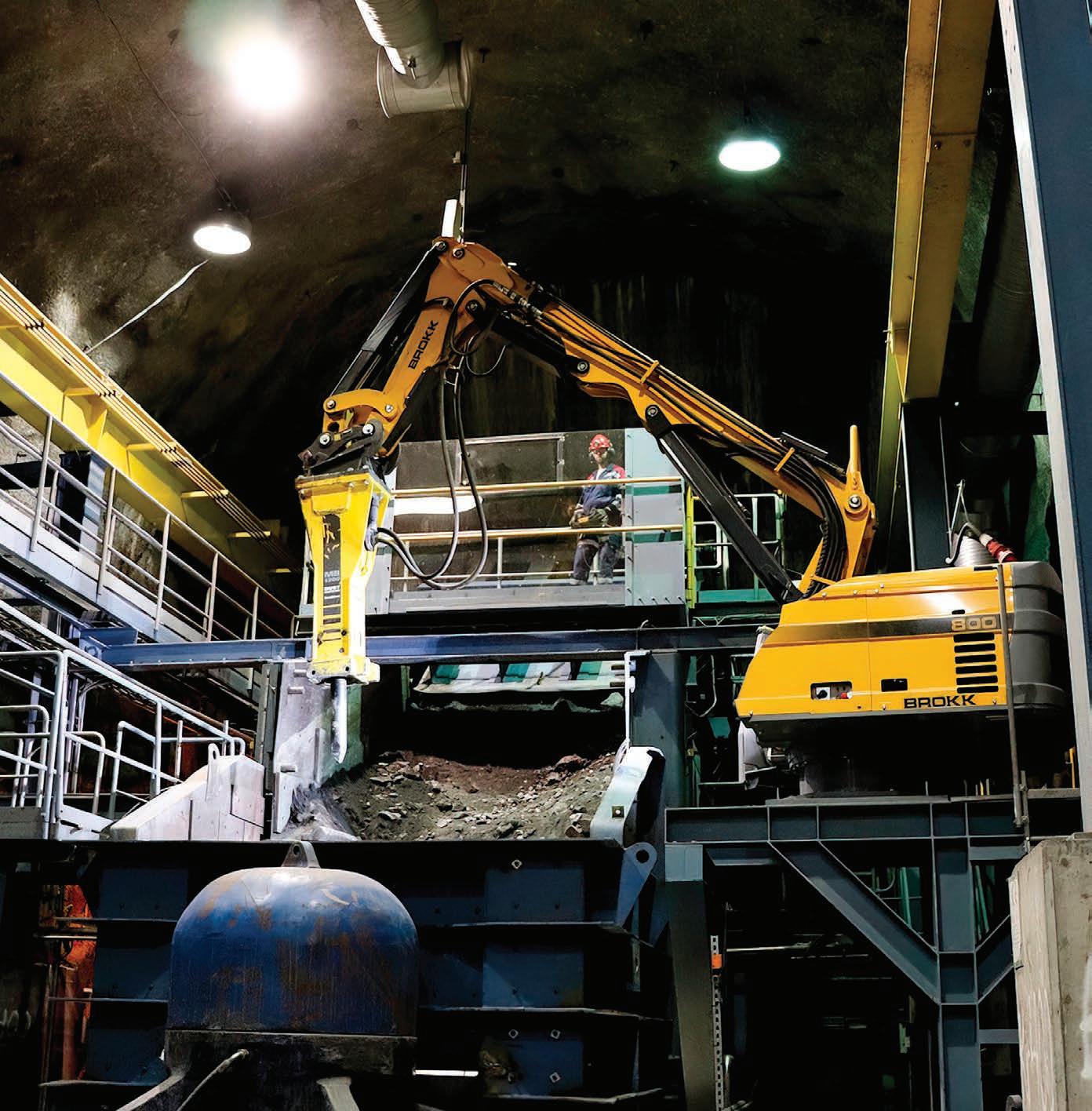


In many emerging economies, access to formal financial services is low. This is of concern to regulators, as access to banking and insurance services is a driver of economic growth.
Savings can be used for productive investment through credit or investment in equities and bonds. And when individuals have sufficient savings and or financial protection, they are more willing to take on risks, including setting up businesses.
It is for these reasons that the United Nations (UN) recognises financial inclusion as one of the keys to meeting the UN Sustainable Development Goals. There are many definitions of financial inclusion, but there are four common themes:
• Access to savings products
• Access to insurance
• Access to credit
• Access to payments mechanisms
In many markets in which banking penetration is low – such as Vietnam – gold has become a primary financial asset.
Some regulators view gold as unproductive, but World Gold Council research demonstrates that this is not the case. Gold can protect wealth, and it has historically generated returns and outperformed many other major asset classes, including fiat currencies. It gives many a sense of financial security.
According to our consumer research in Vietnam, 81 per cent of people see gold as “a good safeguard against periods of political or economic uncertainty”. This in itself is key to encouraging risktaking, which ultimately is a source of economic development.
Financial risk-taking can lead to productive investment – including investment in businesses or infrastructure projects. Gold directly and indirectly contributes to economic development.
Gold’s liquid nature means it can be sold quickly and easily to meet unexpected financial needs. It can be used as a source of collateral – not just for loans, but in some cases as working capital for small businesses. This is the case in Vietnam, where many have used gold as working capital for business purposes.
Finally, gold can be used as a payment. Again, in Vietnam, it is not uncommon for gold to be used as a down payment on real estate or other investments (for example, a motorbike). Our research shows that 95 per cent of payments in Vietnam are made with cash or gold.
Australia is obviously a very different market, and access to banking services and sophisticated financial products is high. But gold still plays an important role.
Our estimates put annual consumer demand for gold in Australia at around 28 tonnes, one of the highest in the world on a per-capita basis.
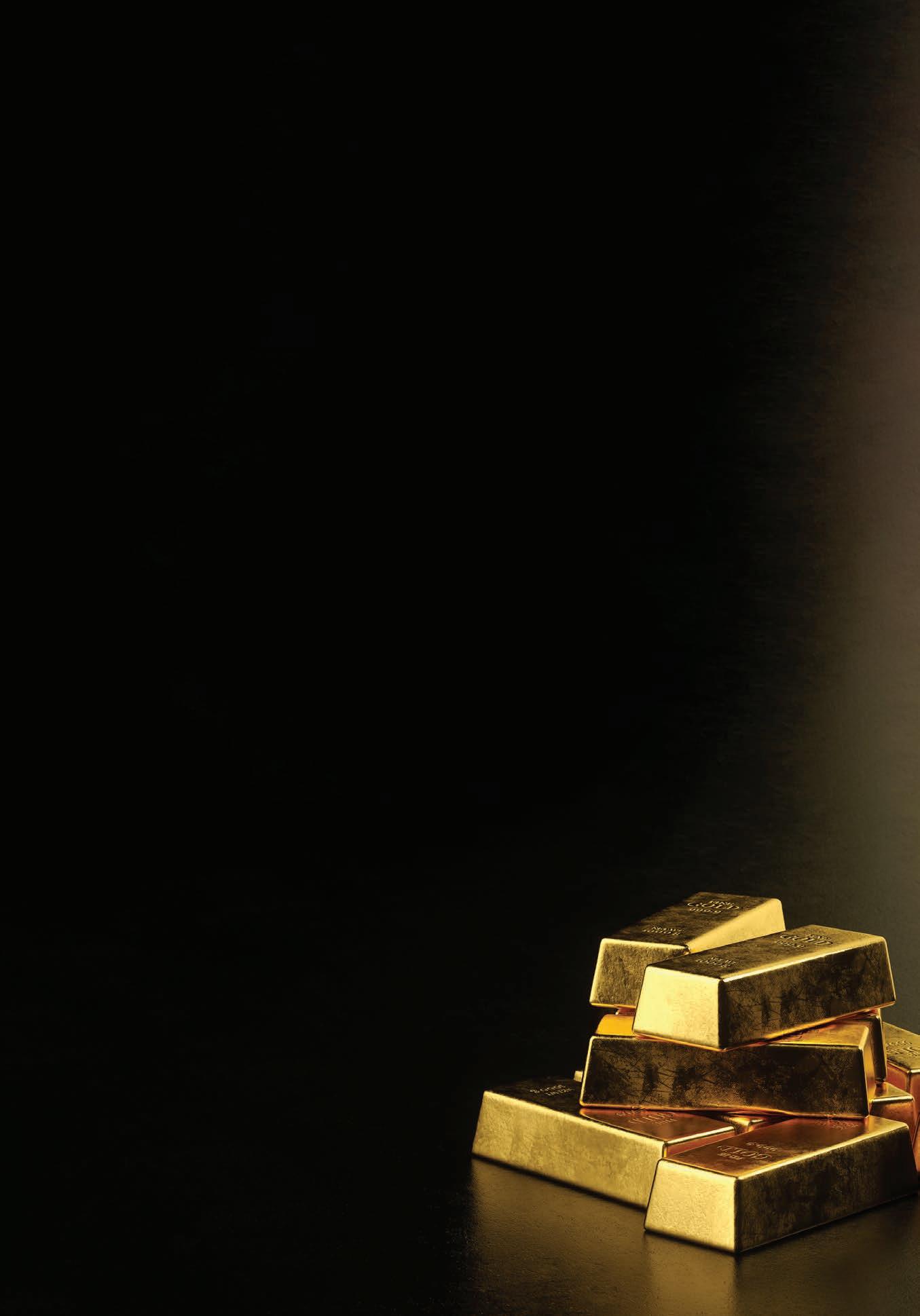
Australia’s demand exceeds countries like India and China,
markets traditionally associated with high consumer demand for gold. At approximately 20 tonnes, gold bars and coins account for most of Australia’s consumer demand. The rest is jewellery.
It’s not surprising that gold plays a significant role in Australian investment portfolios.
Turning to institutional investment, World Gold Council analysis illustrates that adding between 7–12 per cent in gold to a hypothetical Australian superannuation fund portfolio over the past 15 years (to 2021) would have resulted in higher riskadjusted returns.
On the back of the gold price rally (in Australian dollars) in the first quarter of 2022, we undertook analysis on why gold should be included in an Australian super fund’s portfolio.
An allocation to gold in a superannuation fund portfolio might help to improve risk-adjusted returns. Andrew Naylor, World Gold Council regional chief executive APAC (ex China), explains how.
That analysis demonstrated that a representative hypothetical super fund portfolio would have experienced lower volatility and losses with a 10 per cent allocation to gold during the first quarter of this year. And over the past 15 years, a hypothetical average super fund portfolio with 10 per cent gold would have seen a higher return, lower volatility and less dependency on global equities compared to a portfolio without gold.
As monetary tightening gets priced in, a key driver of interest in gold will be inflation, which remains elevated in many countries. Global money supply has climbed at an unprecedented rate since the outbreak of the COVID pandemic, seeding higher inflationary pressure, and surging commodity prices have poured fuel on the fire.
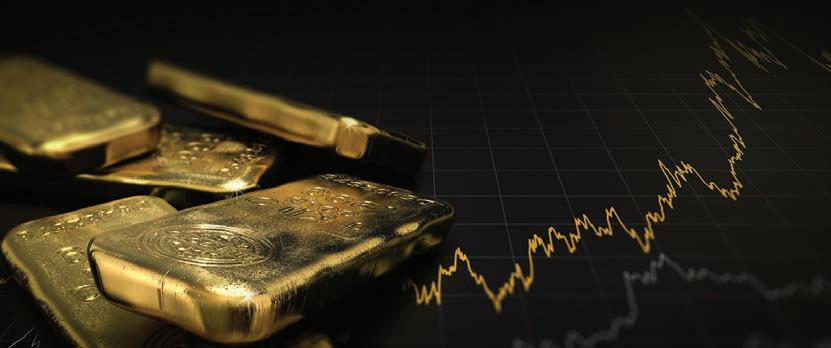
In the US, year-on-year growth in the Consumer Price Index (CPI) reached 7.9 per cent in February, the highest since January 1982, while Australia’s Retail Price Index (RPI) surged to a record high this year.
Australian super funds are heavily concentrated in bonds and equities. Equity market valuations often fall prey to heightened inflationary pressure.
First, investor expectations of companies’ future earnings – the denominators of the price:earning ratio usually rise with inflation. Another potential consequence of higher inflation is a reduced economic growth rate, which often translates into lower equity valuation. Higher rates can lead to more volatility in equity markets.
This is where gold can help. It often performs well during equity market pullbacks, and can be an effective risk diversifier and inflation hedge.
It is for these reasons that gold allocation in a hypothetical superannuation fund portfolio might improve risk-adjusted returns.
What is clear from our research and analysis is that gold has broad appeal. Consumers and institutional investors, whether in emerging or developed markets, would do well to consider gold as part of their portfolio mix.

Andrew Naylor joined the World Gold Council in 2016 and since 2020 has led our regional office in Singapore. Originally part of the central banks and public policy team, Andrew was responsible for our Islamic finance initiative, culminating in the launch of the AAOIFI Shari’ah Standard on Gold.
Andrew started his career at international consultancy firm Cicero Group advising financial institutions on foreign investment and trade policy in Asia, and the global regulatory reform agenda. In this role, he provided economic and political commentary for global broadcasters including the BBC, Bloomberg, CNBC and China Central TV.

Mitchell Services has developed a solution enhancing the accuracy and efficiency of drill programs deep undercover. Meet Mineral Performance Drilling.
Mineral exploration is a difficult˛and expensive trade, and with the search for deposits getting deeper, drilling innovation is needed to uncover the world’s orebodies of the future.
Through its Mineral Performance Drilling (MPD) solution, ASX-listed Mitchell Services (MSV) is enhancing the accuracy of drill programs, especially for resources under sedimentary cover, including base and precious metals.

As Mitchell Services chief executive officer Andrew Elf explained, the idea for MPD came about almost unexpectedly.
“The team was together, and the idea came up in conversation,” Mr Elf told Australian Resources & Investment.
“We thought, ‘We’re doing this sort of drilling, methodology and technique in metallurgical (met) coal and we’ve done it in oil and gas previously’.
“So we said, ‘Well hang on, there’s going to be areas of mineral exploration that have a similar top cover sequence’.”
Mr Elf said for Mitchell Services to validate the new solution, the company had to contend with one divergence.
“The previous holes in coal and oil and gas were vertical holes, whereas mineral
holes undercover have traditionally been inclined holes,” he said.
“We knew the technique worked so the test was applying the new approach to an inclined hole and then getting a client to give it a go.”
Mr Elf said once a client implemented the solution and realised the benefits, MPD was born.
Designed in-house by Mitchell Services, MPD enables drilling through deep cover sequences at speeds of up to 60m/hour.
Mr Elf said a critical advantage of MPD is the ability to “target and direct the drill hole”.
“MPD can steer, track and manage where the hole hits. And if you think about what you’re doing with the MPD technology, you might be doing a diamond coring tail and attempting to hit a target underground with pinpoint accuracy.
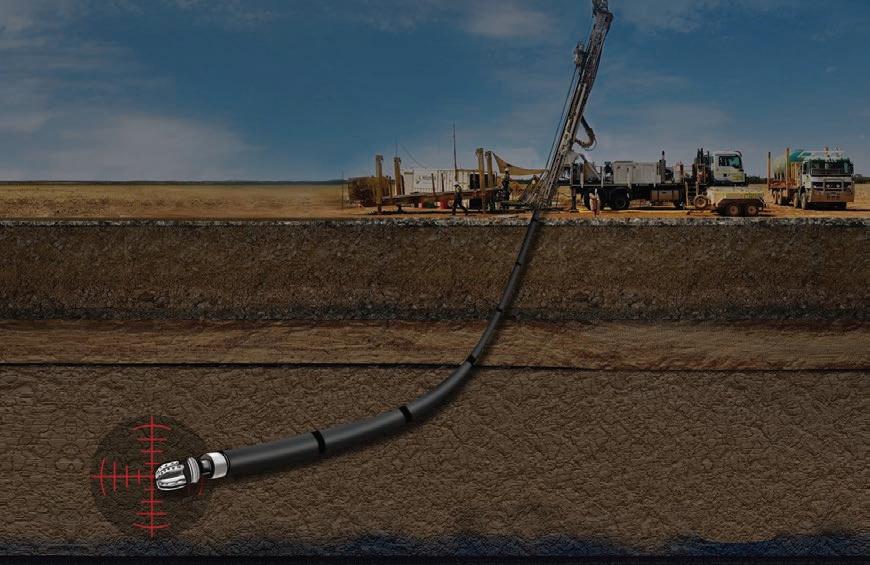
“Drilling the top section using MPD certainly sets you up for a greater level of success with the rest of your hole, which should be an easier drill and there are several other benefits that flow from that.
“MPD is a quicker method of drilling, and we’ve got examples where people were originally taking 15 shifts and we were doing it in four.
“So for an exploration project or resource drill out, where there could be geologists, messing, camps and everything else, clients can get a project done quicker and significantly reduce their cost per metre.”
Mr Elf said faster drilling speeds up the entire exploration program and broader strategy, with companies able to get data to the market quicker and announce results faster or get answers and troubleshoot more readily.
There are also safety benefits.
“When we’re drilling the top-hole section, the rods are rotating at very low revolutions, and we also use automated rod
handlers to handle the rods that do MPD. So we’re minimising hands-on-steel,” Mr Elf said.
Mitchell Services general manager –commercial Todd Wild said because of MPD’s accuracy, mining companies are saving metres while delivering the desired result.
“MPD removes a lot of the potential downhole issues when diamond drilling begins and reduces the need for navi work as the hole is so accurate,” he told Australian Resources & Investment.
Mr Wild said MPD also enables exploration teams to retrieve and reuse drill casing.
“Because we can keep the ‘flight path’ of the hole so straight and consistent, MPD allows the drill crews to more easily retrieve the casing after each hole is completed.
“If you’re performing a resource drill out through 500m of cover and can re-use your casing each time, that alone is a material reduction in your drilling budget.”
The technology can be applied across all of Mitchell Services’ surface fleet and its associated equipment, enabling quick and efficient deployment.
Mr Wild said MPD is now being used across Australia.
“We’re using MPD in the Mount Isa region, in central Queensland, as well as the Paterson Province in Western Australia,” he said.
“Both new and existing clients are using MPD, each of whom have taken a leap of
faith to give this technique a go and it’s paid off.
“And it’s not just a slow benefit, it’s from the first hole. Where for every hole drilled, MPD is changing the cost per metre dramatically.”
As greater pressure is applied on project timelines as the global energy transition heats up and the need for new minerals becomes more urgent, harnessing efficient and accurate technology will become more critical.
Industry analysts and mining companies have flagged a future copper deficit and Mr Wild believes MPD can go some way to supporting this.
“MPD has a significant role to play in the pursuit of critical minerals, particularly as it can be applied across key geological settings throughout Australia and the world,” he said.
“These days miners are looking at a decade or more from discovery to production.
“MPD is a vital way to really speed up the feasibility stage of a project by improving the speed of drilling and condensing timeframes.”
Achieving the world’s net-zero objectives will take a group effort, and relevant stakeholders will need to be at the top of their environmental game to win over discerning investors.
MPD is an example of Mitchell Services finding a better way – a solution that furthers what was already Australia’s premier drilling services company.

Epiroc strives to drive productivity and sustainability transformation in the industries it serves, and the global mining sector is a key beneficiary.
When Epiroc was created in 2018, previous owner Atlas Copco carefully picked the company’s name, with ‘Epi’ meaning “on” or “at” in Latin and Greek and ‘Roc’ signalling stability and durability.
Four years on, Epiroc has leveraged its strong foundations to become one of the most trusted and respected original equipment manufacturers (OEM) in the global mining industry.

Consistency and reliability have been key propellants of Epiroc’s rising profile, while the company’s penchant for growth has accelerated that even more.

One of Epiroc’s key missions is to drive productivity and sustainability transformation in the industries it serves.
“Together with customers and business partners, we develop safe and sustainable products and solutions that increase productivity and lower costs,” an Epiroc mission statement reads.
“Automation, electrification and digitalisation are in focus in our innovation work.”
Epiroc’s constant pursuit of innovation is underpinned not only by its strong and committed in-house team, but also by its desire to expand.
In June, Epiroc bolstered its Australian electrification ambitions by acquiring JTMEC, a Perth-based electrification solutions provider for underground and surface mines.
Established in 2005 and home to 190 employees, JTMEC’s offerings include highvoltage installation and maintenance work, transformer servicing and testing, engineering design, feasibility studies, and training.
The company also manufactures electrical products, including substations and mine chargers, and is currently providing services for Australian mining operations such as Olympic Dam, Dargues gold mine, DeGrussa copper mine and Northparkes.
Also, in mid-September, Epiroc announced it had agreed to acquire a 53 per cent stake in Radlink, a Perth-based provider of wireless communication solutions to mines.
The acquisition of the majority ownership is expected to be completed in the fourth quarter 2022.
“Radlink’s powerful network connectivity solutions will support Epiroc as we continue to provide mining companies with automation and digital solutions that make operations safer and more efficient,” Epiroc president and chief executive officer Helena Hedblom said.
Other recent acquisitions supporting Epiroc’s electrification focus include the addition of Canadian companies, FVT Research and Meglab.
FVT Research designs diesel-to-battery conversion kits and rebuilds mining machines to electric versions.
FVT recently participated in a successful project to convert the diesel-powered Epiroc Scooptram ST1030 loader to battery electric.
“Bringing the strong team at FVT Research into the Epiroc group fits perfectly into our strategy to provide emissions-free batteryelectric vehicles,” Hedblom said.
“Our customers are increasingly discovering the significant benefits that come with using battery-electric vehicles, and FVT Research’s technical expertise and competence will be key assets for Epiroc as we continue to provide more solutions in this area.”
Meglab is a technology integrator able to design, manufacture and install cost-effective electrification and infrastructure solutions, including battery-charging infrastructure.
As of September, Epiroc had completed seven acquisitions in the preceding two years, reinforcing the company’s expansionary goals.
Running in parallel with Epiroc’s continued expansion, the OEM recently announced an organisational change to further support its automation and digitalisation objectives.
This involved Jonas Albertson, the thenpresident of Epiroc’s Technology and Digital division, being appointed as chief technology officer, where he will have responsibility for the development of common automation, digital platforms and group IT.
Epiroc has also created a reformed Digital Solutions division, which will have commercial responsibility for the company’s digital products and services, including acquired businesses.
“Automation and digitalisation are technology shifts that are happening quickly. With this organisational change we are enhancing our focus in these vital areas,” Hedblom said.
“We will have a dedicated commercial division for our digital business and a technology organisation that can deliver long-term competitive solutions for the whole group.”
As the global mining industry hurtles towards a decarbonised future, miners are going to need more tools to drive down their Scope 1, 2 and 3 emissions.
If Epiroc doesn’t have these tools already, the sector can be rest assured the OEM has them on its to-do list.






RPMGlobal has developed a solution that’s revolutionising operational understanding and decision-making on a mine site. Introducing XECUTE.
“XECUTE was designed with the vision of being a live, multi-user, mine planning environment that updates as changes were made, so it is very different to anything seen before.”
RPMGlobal’s (RPM) XECUTE product manager James Kennon provides insight into the development and creation of the ASX-listed company’s short-term mine planning and execution solution.
“We were looking to create something completely new that integrated all the systems on a mine site and updated in realtime,” Kennon told Australian Resources & Investment
“We wanted planners to have their ERP (enterprise resource planning) systems, maintenance and fleet management systems and geological data update in real-time, so users have full visibility of live changes.
“That’s where XECUTE stemmed from and started – that multi-user experience where planners can see changes on the fly and can plan from any location. This is really important for our users.”
XECUTE is a short-term planning and execution solution used globally, supporting mining operations to achieve their short-term
planning objectives and streamline their processes to ultimately achieve more tonnage and ship more ore
It is used around the world to plan the movement of more than 11 million tonnes each day and supports more than $91 billion of shipped product each year. The solution is used across 12 different commodities.
So, apart from having a live game-like experience with a multi-user approach, why is XECUTE so popular?
According to Kennon, a key driver of its success is the fact the solution provides operational teams specific, real-time instructions to achieve their objectives.
“XECUTE does this by providing the planning team with a more accurate and faster
method of communicating that information,” he said. “The software integrates directly with other enterprise solutions and uses relevant information to provide decision support and context to the mine planner who’s making those decisions.
“And with the rich graphics engine and integration capabilities XECUTE has, we can provide visualisation which is easy for the operations team to understand. They can see where they need to go, understand what they’re doing and understand the interactions between different machines.”
An example is XECUTE’s ability to transfer information from the platform to dispatch and fleet-management systems, enabling information to appear in an operator’s cab.
Plan compliance is critical in the modern mine and XECUTE provides a plan to guide operators on where they’re supposed to be and what they’re supposed to be doing at any point in time. This comes from the integration of key systems.

“Everything from maintenance activities to how much material a train is carrying on its way to port can be instantly updated in XECUTE from the single source of truth,” Kennon said.
“This way the planners are working with the most up-to-date accurate information all the time.
“We can project how much material will be at the stockyard in a week’s time and indicate in real-time whether you are on-track to meet the target.”
XECUTE provides the right information at the right time to enable short-term planners and the operations team to understand how the mine site is performing at any given time.

And the real-time nature of XECUTE means if operator performance is down, short-term decisions can be made to rectify the situation.
RPMGlobal solutions executive Chet Fong said XECUTE was being extended from shortterm planning into operational planning.
“There are very few, if any, other companies in that operational planning space,” Fong told Australian Resources & Investment.
“This is now down to half hourly, hourly, daily shift-level planning where other companies traditionally use Excel.
“Because XECUTE can react quickly to changes and offers the visibility of the corresponding impacts, it can also be utilised in operational planning. None of the other shortterm planning tools out there can react quickly enough to do this.
“That’s a key differentiator for us when it comes to XECUTE.”
In operational mine planning, companies are trying to anticipate what will happen in the next 24 hours rather than the coming week or beyond. Planners can only make decisions if they have current and accurate information in order to understand what the impact of that potential decision might be.
Kennon said accelerated decision-making enables operational teams to meet their targets and key performance indicators.
“By pursuing a more dynamic approach, operations begin to understand the value of tackling problems as they come up, rather than
delaying challenges until they become more difficult to manage,” he said.
“And if you can shorten the cycle between understanding there is divergence and trying to rectify the situation, the more likely you are to get back on track by strategically allowing more time to process potential decision paths.
“This is key to XECUTE. By being able to bring in that real-time information we can support the ability to replan within the shift. Even without an immediate action, the planner is made aware of updates, enabling them to adjust their plans accordingly for the next shift or the shift after.
Fong said more and more organisations are looking to manage the operational planning with digital solutions.
“It makes no sense to put all of the effort into sophisticated short-term planning only to hand off to whiteboards and paper-based systems for the next week,” he said.
“In that context, XECUTE is continuously updating the plan as the reality of the situation changes.
“For example, if you were to lose the main shovel for a shift you can quickly replan upcoming activities knowing the impact that will have on the shift, the day, the week. And then you can instantly communicate the plan with the entire workforce, enabling full visibility.
“Ultimately, we are providing a solution for the people that are making decisions, enabling them to make better decisions more quickly, more accurately, and more often.”

Demolition work requires equipment that is tough, powerful and safe, qualities that underpin Brokk’s range of remote-controlled industrial platforms.
Since the early 1980s, Brokk has been at the forefront of developing a range of highly advanced demolition robots for use across multiple industrial applications globally.
The company has supported everything from mining, tunnelling and construction projects to metal and cement processing to nuclear power plant service and maintenance and decommissioning activities.
Brokk’s range of groundbreaking and reliable demolition robots provides unique characteristics and countless options for a number of industry applications.
Operating with maximum power on minimum energy input, the robots feature optimal real-life ergonomics and many unique characteristics suited for harsh environments, significant stability and advanced radio technology, easy on-site servicing, and an array of accessories and configurations.
The compact design of Brokk’s demolition robots means they can easily access confined spaces without compromising on power and safety. They also carry various attachments that do not emit exhaust fumes.
“The Australian market currently has over 200 Brokk robots in operation across mining, tunnelling and construction projects, along with other potential applications, including the Australian Defence Force, where our technologically-advanced equipment could be utilised in the future,” Brokk Australia managing director Will Visser told Australian Resources & Investment
Brokk provides both mobile and fixed plant solutions for the mining industry.
The company’s demolition robots can perform various mining-related tasks such as scaling, oversize rock-breaking, digging, drilling, secondary breaking, scaling
bottom shaft cleaning and many other duties.
The fixed pedestal boom is a compact, stationary breaker system for the mining and aggregates industry and is designed to operate in low headspace and hard-to-access areas as low as 1.83m.
The unit has precision hydraulics and is easy to operate with modern controls and 360° slewing thanks to its unique three-part arm system and a reach up to 8.5m. This allows it to cover a large part of the grizzly to deal with any odd-shaped and oversized rocks.
Mobile solutions provide versatility that can streamline mining operations and limit emissions, allowing operators to move between different attachments and much larger tools without needing to increase shaft size.
Brokk prides itself on its open innovation practices and ability to solve complex problems on behalf of its customers.
“A customer will come to us with unique challenges, usually due to safety or environmental concerns,” Visser said.
“With the strength of our global company, manufacturing capabilities and the versatility
of our machines and attachments, we are able to find solutions to complex problems for our customers, which often challenge other suppliers.
Visser said Brokk’s machine is one-of-a-kind system that is currently in use in many mining applications worldwide.
“It’s compact, robust and versatile, and you can operate it under the harshest of mining conditions,” he said.
“Operators love this machine, as it can be manoeuvred into confined and difficultto-access spaces reducing safety risks and increasing productivity.”
Safety is at the heart of the remotecontrol technology underpinning Brokk’s demolition robots.
Inherent hazards and risks associated with underground mining – such as falling material and other dangerous events – can be reduced by deploying demolition robots into mining applications, significantly improving safety outcomes.
“Brokk is always engaged in open discussions with mining operations around safety,” Visser said.
“We want to improve safety and remove people from hazardous places and the company is 100 per cent focused on making Australian underground mines less hazardous.
“Brokk’s stabilised remote-controlled demolition robots, employing a sturdy track system with well-protected cylinders, are a safe and more effective way to carry out several key tasks in underground mining applications.
“Operators working remotely with the Brokk demolition robot are removed from any physical harm, and the machine improves productivity at the same time.”
All systems are remotely operated and feature Brokk’s SmartRemote technology. The standard remote operation solution features an ergonomic and intuitive remote control and allows the operator to maintain a safe distance with a range capacity of up to 300m.
The networked remote operation solution allows operators to control the robot while sitting in a control room. The machine is connected and operated over ethernet or Wi-Fi and can be operated from 2000m away or further with enhanced network configuration.
An ergonomic Brokk control station with integrated controls and video screens enables video and audio feedback, enhancing the operator experience and optimising operability.
Brokk’s SmartPower technology provides intelligent power management with a unique electric powertrain that increases the robot’s output.
The original equipment manufacturer’s (OEM) continued investment in research and development (R&D) over the last 40 years has resulted in continuous improvement to the machines.
Compared to other systems on the market, the robot’s electrical design components and contacts have been reduced to a minimum. Brokk’s electrical system and components are designed to withstand extreme vibrations, dust and rough handling.
Brokk’s SmartDesign ensures service and maintenance are streamlined, minimising machine downtime.
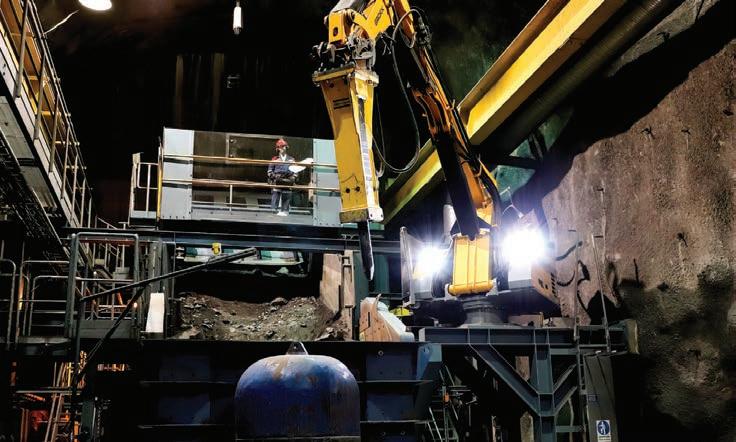
Daily and weekly maintenance can be carried out without lifting a machine cover. For example, all greasing points, including the breaker grease refill, are easily accessed from the outside.
Hose replacement on a Brokk machine sees simple outrigger hoses be divided, which means only short sections need replacement if damaged. These design improvements help to ensure machine maintenance is efficient and easy to carry out.
Operating a global network, Brokk focuses on providing its customers with reliable and knowledgeable after-sales service and support.
“Our demolition robots are working in underground mining environments throughout the world, successfully improving safety, maximising productivity and reducing repair and maintenance costs,” Visser said.
When it comes to supporting service technicians, Brokk has incorporated technology that reduces the risk to personnel operating in these often-confined sites.
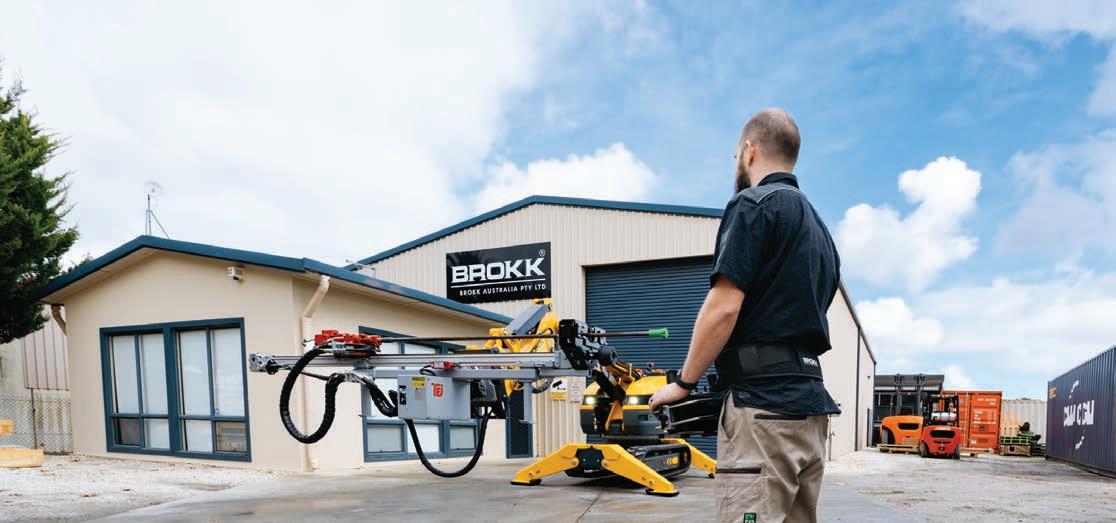
Brokk Connect is an online platform developed for connected Brokk demolition robots and designed to simplify the management and care of the machine.
The software enables customers to locate and manage their entire robot fleet, providing real-time data to manage operating and maintenance requirements while maximising productivity.
Brokk also provides specialised training courses for both Brokk operators and service personnel. The Brokk Academy also works as a practical guide for expanding the application of the robot with the addition of other attachments.
Opening its Australian office in March 2021, MIRS Robotics is rapidly elevating its local presence, proving why robotics is an important addition to any mine site.
MIRS’ haul truck washing and haul truck refuelling solutions have been developed in response to mining’s automation movement.
Oyabán said these products “offer a continuous and autonomous operation with the same known benefits of other MIRS solutions”.
MIRS’ Australian office was opened in March 2021 and despite the Chilean company only having a local presence for a short time, it has already been involved in feasibility and test design projects with a few major miners.
“In preparation of a strengthened presence in Australia and the Asia-Pacific region, we have been negotiating and forming up our collaborators in the local market, among them are some multinational and globally reputable firms,” Oyabán said.
Robotics is becoming more prominent in the global mining industry as companies seek a safer, more efficient and more reliable operation.
MIRS Robotics is the only global company exclusively dedicated to providing robotic solutions to mining and heavy industries. The company is not only championing robotics on an exciting new scale, but is also educating miners of a new operational approach.
MIRS was established because founder Hugo Salamanca saw robotics as a way to improve many of the mining industry processes where safety concerns and repetitiveness were prevalent.
“MIRS started as a sub-project of HighService and, after signing a commercial agreement with KUKA Roboter in 2005, managed to implement its first robotic solution, a base plate replacement machine in the Radomiro Tomic mine in Chile,” MIRS commercial director –Americas Rodrigo Oyabán told Australian Resources & Investment.

MIRS has developed more than 40 solutions for mining and heavy industries. So what are the key applications for robotics in mining?
According to Oyabán, robotic solutions are best suited to mining’s “repetitive and dangerous” tasks.
“Mining is one of the many sectors in which repetitive and high-risk processes account for most of the operation,” he said.
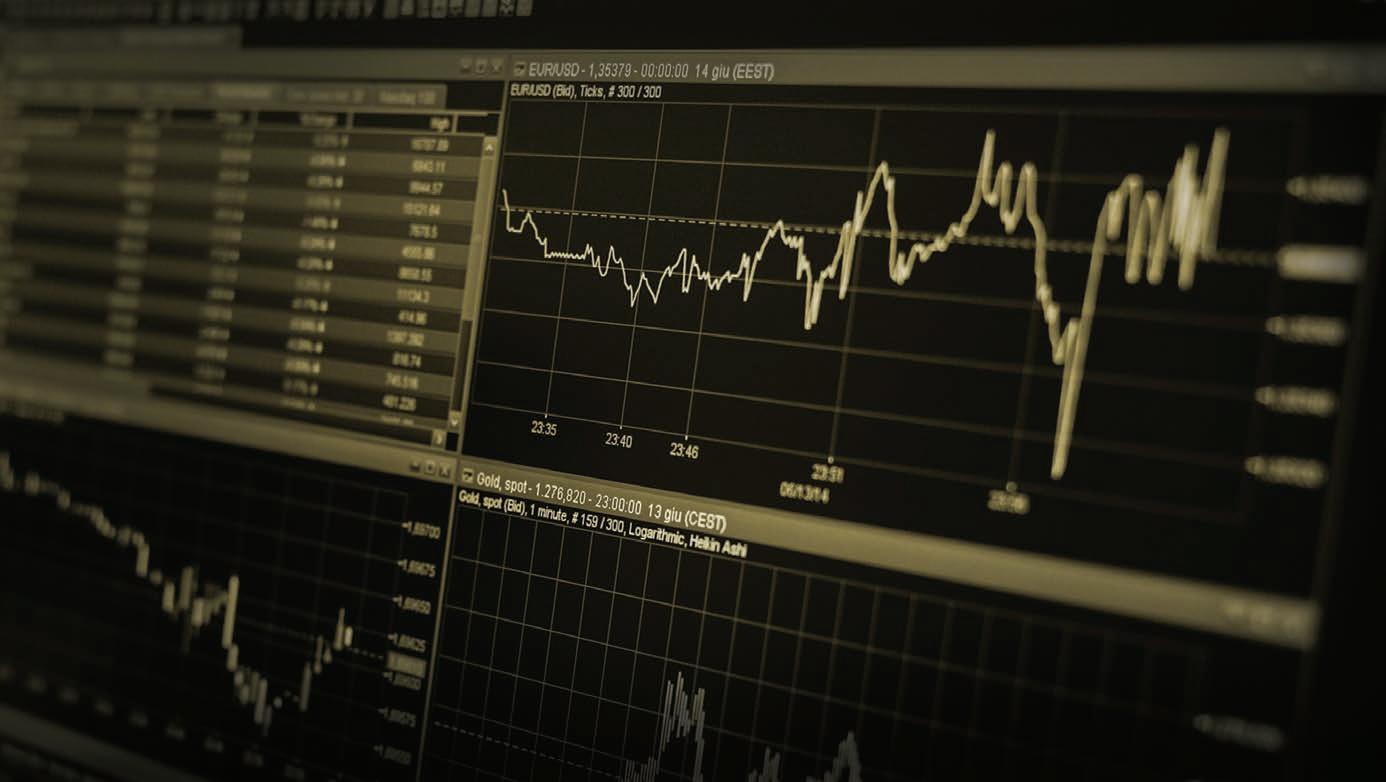
“This justifies the need to protect personnel by implementing robotic solutions and consequently improving process reliability and final product quality, and reducing operational costs.”
MIRS offers robotic solutions to support various aspects of the mining process, with mining, comminution, shipping, refining and smelting the key focus areas for its customers.
Oyabán said the MI robotic sampler was MIRS’ most mature solution.
“The MI robotic sampler is a speciallydeveloped solution for sampling ore concentrate, whether it be from maxi-bags, drums, trucks or trains,” he said.
“We are working on some serious prospects which we believe will yield in the installation of our solutions in Australia – similar systems that are in use across the Americas mining sector.”
If a customer is interested in installing a MIRS product, the company offers a wide range of services to ensure the solution is as specific as possible. This includes design, detailed engineering, factory tests, final acceptance testing and assembly supervision before the product is commissioned.
MIRS also offers after-sale services to support its customers through a product’s life, as well as customer training.
Oyabán said as the global mining industry embraces the need for greater safety and productivity outcomes, robotics was increasing in popularity.
This includes the Australian mining sector, which, while trailing the Americas for robotic uptake, is beginning to see the strategic advantages.
And considering the labour crisis plaguing the local sector, robotics is not only a strategic solution but also a pertinent one.
As the leading international event series connecting sophisticated investors from around the world with mining company management teams. Mines and Money will leverage off the scale of the International Mining and Resources Conference (IMARC) and bring its unrivalled network of investors to the ICC Sydney from 2-4 November 2022.
Being co-located alongside Australia's largest mining event, will not only put mining companies in front of hundreds of investors that are attending, but will also reach thousands of private investors, with the event expecting upwards of 7,500 attendees.
Over 120 mining and energy companies are expected to attend. Showcasing global projects from diversified producers and some of the most compelling exploration and development companies.
Mines and Money @IMARC provides an excellent opportunity for professional investors to meet exciting explorers on the cusp of the next
big discovery, near-production development companies and cash generative producers to discuss their next big mining investment.
Gold, silver, copper and battery metals are just some of the commodities you can expect to hear about from some of the greatest leaders in mining, investment and finance with more than 250 mining and resource experts providing the latest market commentary, project updates and insights into current commodity trends that can shape investment strategy.

Australia’s mining and resources sector has a vital role to play in the global energy transition.
IMARC takes place in Sydney from November 2–4, bringing together the most influential people from across the global mining industry. So what can we expect from the conference?
The changing discourse around the role of ESG (environmental, social and governance) for institutional investors has forced a rethink to portfolio management, particularly those tied to the mining and resources sector.
However, senior investment analysts predict Australia’s mining and resources sector will be vital to the global decarbonisation transition and warn against disinvestment.
Australia’s commitment to sustainability, rule of law and efficient infrastructure makes it an attractive proposition for investment in the mining and resources sector.
The interwoven challenges between decarbonisation and good investment strategies are to be debated at the International Mining and Resources Conference (IMARC) in Sydney in early November.
A major focus for investors right now is the mass-decarbonisation across the entire mining value chain, but global hurdles are slowing efforts and putting an emphasis back on providing cost-effective, quickly sourced energy forms to help nations struggling with power generation.
“There’s no question that there’s a global trend towards decarbonisation,” Queen’s Road Capital Investment chief executive officer and director Warren Gilman said.
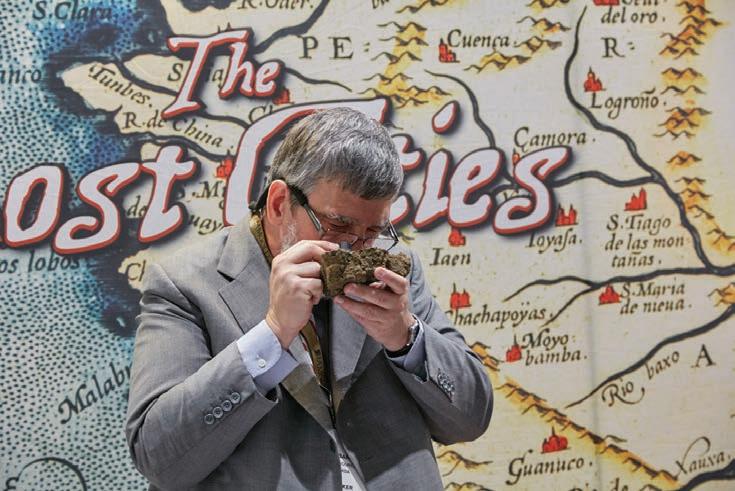
“Even though we’re suffering some extraordinary bumps in that road at the moment, that’s the inevitable trend.
“And that opens up different pockets of opportunity. Divestment in the carbon industry, whether it’s gas or coal or natural gas, means there is more investment in alternative fuel sources like uranium.
“Decarbonisation generally tends to also mean electrification, and that obviously has an impact on demand for battery metals. But necessity often trumps trends like this and we’re seeing a short-term necessity for the re-investment in carbon-based energy forms around the world to fill what is hopefully a short-term requirement.”
A major reason for that requirement is Russia’s invasion of Ukraine, which is
disrupting energy sources within Europe and beyond, with a flow-on effect reaching around the world.
“Russia was a big importer and exporter of coal,” SW Accountants and Advisors partner Blayney Morgan said.

“You stop the imports which were mostly from Ukraine and you stop the exports, and you’ve really mucked up the entire market.”
The impact of Russia’s actions has also highlighted the global susceptibility of relying on foreign resources. This is forcing many countries to rethink the role of globalisation within their own economy.
Australia has a long mining history and the right infrastructure to capitalise on investment opportunities.
However, while domestic self-sufficiencies might seem an attractive proposition, this is not necessarily an achievable prospect.
“There’s certainly a much greater awareness of the idea of the security of supply chains and domestic production due to the impacts of COVID, the invasion of Ukraine and the polarisation of global politics generally,” Gilman said.
“Countries have realised that you are putting your populace at heightened risk by not having a domestic supply chain and a domestic source of inputs, so there’s an increased realisation of that risk.
“I wouldn’t say there’s a trend towards mitigating that risk yet, but people have been talking about it more and making some movements in that regard.
“For example, there’s been an increase in the global discussion about domestic sourcing of what are viewed as critical minerals for chips and semi-conductors.
“This isn’t new. That risk didn’t happen overnight, just awareness has increased. I think there’s always been some awareness, but it’s been combined with complacency and at the end of the day economics has tended to trump the risk.
“The incentive is just not there to prioritise domestic resource security and the government has had other priorities. They’ve been all about efficiency and cost reduction, not about security, so I’m not sure that’s going to change.”
And until domestic supply chains become more of a priority, places like the United
States, Australia and Canada are providing the best investment opportunities.
“Australia is top of the heap. It’s in a wonderful position. Along with Canada, the two countries are the best to invest in when it comes to mining,” Gilman said.
“You have access to courts that are viewed as fair and reliable and that is the biggest advantage any country can have. After that, you need the resources in the ground and obviously Australia has a tonne of those.
“You’ve got a population that has, for lack of a better description, mining in their blood. Australia has a history of mining and a significant part of its population makes its living from mining and a mentality that responsible mining creates wealth and opportunity with minimal damage.
“As long as you’ve got that mindset, you’ve got an opportunity to develop those resources.
“Australia also has very sophisticated capital markets. And because of its history it’s used to financing mining opportunities, which is critical for the viability of the industry.
“One might argue that nowhere else in the world has the mining building blocks to the degree that Canada and Australia have them.”

Morgan echoed Gilman’s sentiment.
“My personal view is Australia is just such an easy place to do business,” he said. “You see it in the valuations with the lower cost of capital and that’s because it’s got the right legal system.
“It has good infrastructure, good people who are well trained and it’s the lucky country mostly because we’re the empty country, which enables the opportunity to build really good projects.”
IMARC is a forum where these rich investment opportunities can be explored with mining heavyweights and exciting newcomers to the industry.
“A key role of IMARC is to highlight challenges and provide a positive and productive forum where people can talk about those things in a safe space rather than feeling like they’re the only ones having that issue,” Morgan said.
Gilman describes it as a chance to take the temperatures of other investors and corporates in terms of what they are seeing.
“I’m looking forward to finding out who’s doing well, who’s struggling, what commodities are in vogue, which ones aren’t, what areas of the country are continuing to support mining and what areas are experiencing more of a push back,” he said.
IMARC has a dedicated three-day stream covering investment and financial issues facing the sector, with over 120 mining companies exhibiting on the expo floor in the mining and investment hub.
A crucial event for any industry investor, IMARC is the only forum of its kind that uses enhanced and accurate networking technology to match delegates, allowing them to pinpoint new business and investment opportunities and start important conversations.


Keep up to date with the latest executive movements across the mining sector, featuring BHP, Core Lithium and Mincor Resources.
BHP recently tweaked its executive leadership team, with Edgar Basto appointed as chief operating officer and Geraldine Slattery as president Australia.
In his new position, Basto will enable acceleration in safety and productivity improvement across the company and have accountability for the continued transformation of the company through the BHP operating system (BOS).
Basto had been BHP’s president minerals Australia since May 2020 and has more than 30 years of operating experience across BHP’s minerals footprint, including time overseeing the company’s two largest assets, Western Australia Iron Ore and the Escondida copper mine in Chile.
Slattery will be responsible for BHP’s Australian operations. She had been president of petroleum from March 2019 until the completion of the Woodside merger this year, leading the company’s oil and gas interests and exploration programs across the world.
BHP chief executive officer Mike Henry said the appointments would enable the miner to build on the strong performance delivered in recent years to drive even better safety and productivity outcomes.
Core Lithium recently appointed Gareth Manderson as its new chief executive officer (CEO), succeeding Stephen Biggins who resigned as managing director in March.
Manderson has 28 years’ experience in the mining and minerals sector and joins Core after serving in various leadership and technical roles within mining giant Rio Tinto for more than 22 years.
His most recent role at Rio Tinto was as general manager – sustaining capital, where he delivered a portfolio of more than 600 projects spending $1.6 billion each year across 17 mines, four ports and a 1900km rail system.
Core chair Greg English said Manderson was the perfect fit for the company’s first CEO as its Finniss lithium project in Northern Territory moves from construction to operation later this year.
“There are many synergies between Gareth’s previous senior roles in managing complex mine, mineral processing, port, township and logistics operations during his tenure at Rio Tinto and the Finniss project, which is 25km from the Darwin CBD and port,” he said.
David Southam recently stepped down as managing director and CEO of Mincor Resources.
With the company’s successful return to the ranks of Australian nickel producers and the ramp-up of its Kambalda nickel operations in Western Australia now well underway, Southam said this was a logical stage in Mincor’s lifecycle for a leadership transition.
After a career spanning more than 25 years at senior executive levels within ASX-listed resource companies, Southam said he wanted to be able to spend more time with family and to pursue personal interests. Southam has overseen Mincor’s return to production status over the past three-and-a-half years.
The board has appointed highly regarded senior mining executive Gabrielle lwanow as Southam’s successor. lwanow has extensive experience working at senior operational and executive levels within the bulk and base metal resources sector.
Iwanow has spent time at global mining giant Rio Tinto and, more recently, with OZ Minerals as general manager of the worldclass Prominent Hill operation in South Australia.
Lithium company Lake Resources recently appointed David Dickson as its new managing director and CEO.
Dickson has more than 30 years’ experience in process technology, engineering, construction, and EPC (engineering, procurement and construction) cost management across the energy sector.
Lake said he had a proven track record in successfully delivering multi-billion-dollar resource projects, which will assist the company’s aspirational target of reaching a production profile of 100,000 tonne per annum of lithium carbonate equivalent (LCE) across its operations.
With four lithium brine projects at its disposal, Lake has the largest lithium lease holding in Argentina.
Lake said Dickson’s expertise will support its rapid growth and ensure its operations will be fast-tracked to achieve key project and marketing milestones.
“This is a major achievement to have secured a CEO like David as Lake goes from project development to construction to become a major lithium producer,” Lake executive chair Stuart Crow said.
“David combines proven leadership experience and engineering expertise with a deep strategic understanding of offtaker and investor perspectives on energy supply chains.”
Newmont Corporation recently appointed Mia Gous as the company’s new senior vice president for its Australia operations.
Gous has 27 years of experience in the mining industry, where she has led heavy minerals, zinc, lead, copper and gold operations in Africa, Europe, South America and Australia. She joined Newmont in 2021 as general manager for its Boddington operation in Western Australia.
Having received the Influential Women in Chile – Leadership award in 2019, Gous was named to Chile’s 100 Female Leaders list.
As senior vice president of Australia, Gous will lead Newmont’s delivery of value through the company’s core values of safety, sustainability, integrity, inclusion and responsibility.
Newmont has also appointed Alex Bates to the role of senior vice president –workplace responsibility.
“Newmont continues to leverage our deep bench of experienced leaders with the appointment of Mia Gous and Alex Bates to these critical roles,” Newmont president and chief executive officer Tom Palmer said.
“Their individual strengths, including extensive operational and management expertise, will be tremendous assets to Newmont as we continue to lead the gold industry through our world-class portfolio of assets and project pipeline.”
Bellevue Gold recently welcomed highly experienced mining engineer Kate Frost as its new general manager of the flagship Bellevue gold project in Western Australia.
With more than 20 years’ experience in the resources industry, Frost has demonstrated exceptional technical skills and an outstanding ability to build and manage strong teams.

Frost was most recently Rio Tinto’s technical services manager. Before that, she held senior management positions with Gold Fields Australia where she played a critical role in the start-up of the Gruyere mine.
“Kate is a highly experienced manager who is people-focused and results-driven,” Bellevue chief executive Darren Stralow said.
“She has a reputation for having a strong work ethic and a commitment to excellence in operations management, underground mining, technical services, mining studies, project management and contract administration.”
FLSmidth.
For those who registered for the previous event dates, the tickets will have automatically transferred to the new dates.
• imarcglobal.com
From acorns, big trees grow. The Melbourne Mining Club’s commitment to the resources sector is highlighted in its Cutting Edge events which provide a forum for small-to-mid-cap exploration and development companies to showcase their activities, management and business strategies in an informal gathering at the Melbourne Town Hall.
Five times a year, the movers and shakers in mineral exploration, engineering, technology, investment, and service and supply providers gather to hear from Australia’s innovative and emerging mining industry businesses.
The Cutting Edge series is sponsored by the Victorian Government’s Department of Jobs, Precincts and Regions and leading international professional services group, PwC Australia.
On November 8, Melbourne Mining Club with welcome Alto Metals, Navarre Minerals and Southern Cross Gold to present, each of which own Australian gold projects in various stages of development.
• melbourneminingclub.com/events/cutting-edge
Taking place in Perth in 2022, the Australian Mining Prospect Awards are a great opportunity to recognise and acknowledge the people and companies in the mining sector for their outstanding work.
Having recently celebrated the 2021 Prospect Awards winners, nominations are now open for 2022, with awards honouring categories such as Indigenous and Community Engagement, Mine Project Success of the Year, Outstanding Mine
look at the energy transition, ESG, sustainability and the circular economy. Rigorously researched by the seasoned Mines and Money team, the reinvigorated agenda incorporates topics and themes that are on point and highly relevant to industry.
With mining driving 38 per cent of the world’s GDP, everyone recognises the critical role it will play in the energy transition. The world is entering a unique window of opportunity to shape recovery and address political, economic, and social disruptions caused by the pandemic. Industries and society need to assess, re-think and transform the way they work.
Catering to future minded c-suite executives, gain insights into decarbonisation, sustainability, and the energy transition with more than 120 talks, panel discussions and keynote presentations taking place across three days.

• minesandmoney.com/london
Hosted in partnership with AusIMM and UNSW Sydney, AusRock 2022 will be held in conjunction with the International Society of Rock Mechanics Regional Symposium from the end of November to the beginning of December.
Offering a hybrid format so delegates can attend the conference either in person in Melbourne or online from anywhere in the world, AusRock 2022 follows on from earlier conferences that have successfully covered the various aspects of geotechnical engineering servicing the mining industry and shared best practices.
BHP, Jennmar, DSI Underground and GSS have confirmed their support, with exhibitions set to be held by Rocscience, Minova, MineGeoTech and DSI Underground.
AusRock2022 will focus on new technologies and developments, industry needs, operational problem solving, and practical case studies which will be required for the future.
• ausimm.com/conferences-and-events/ausrock






































